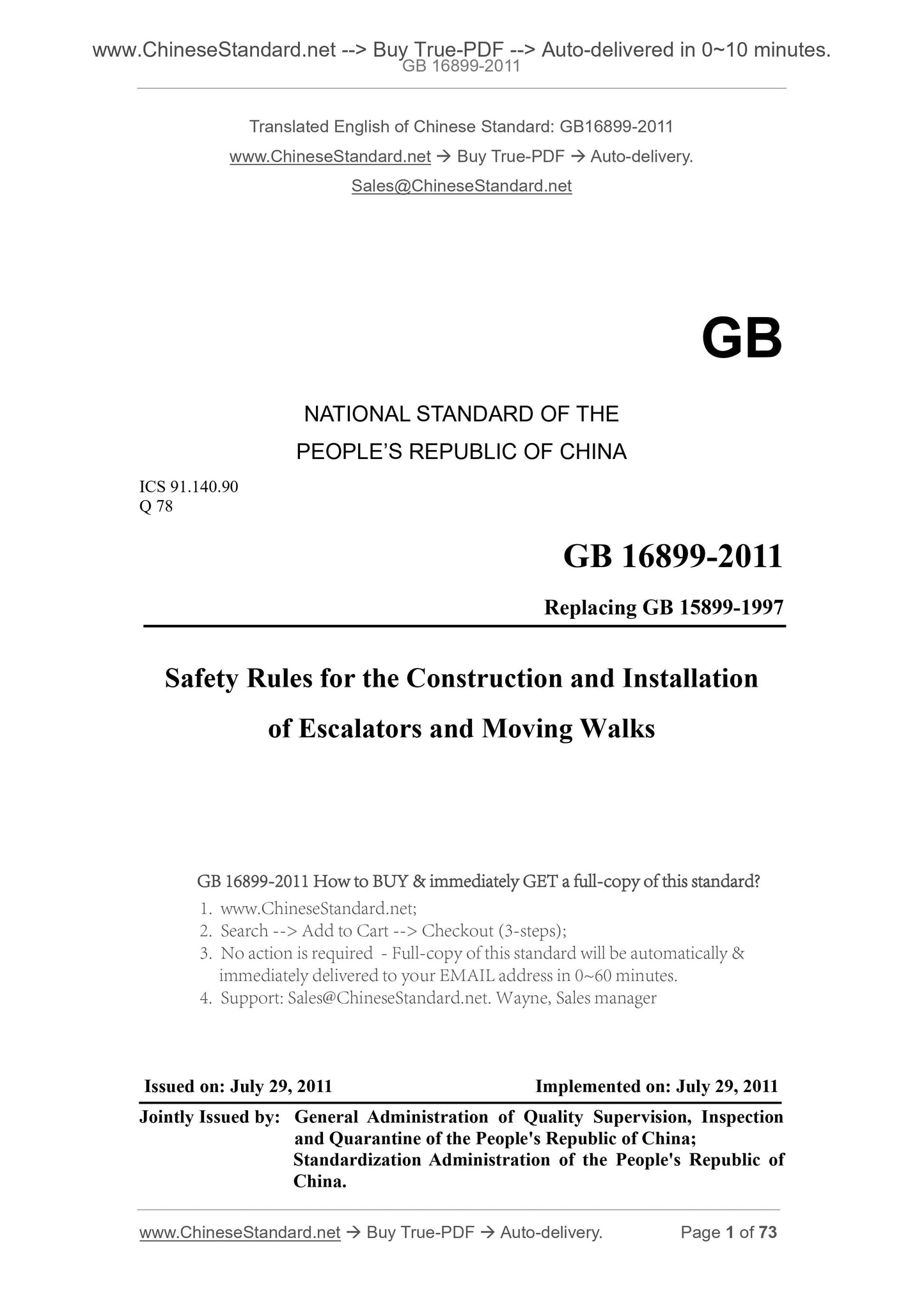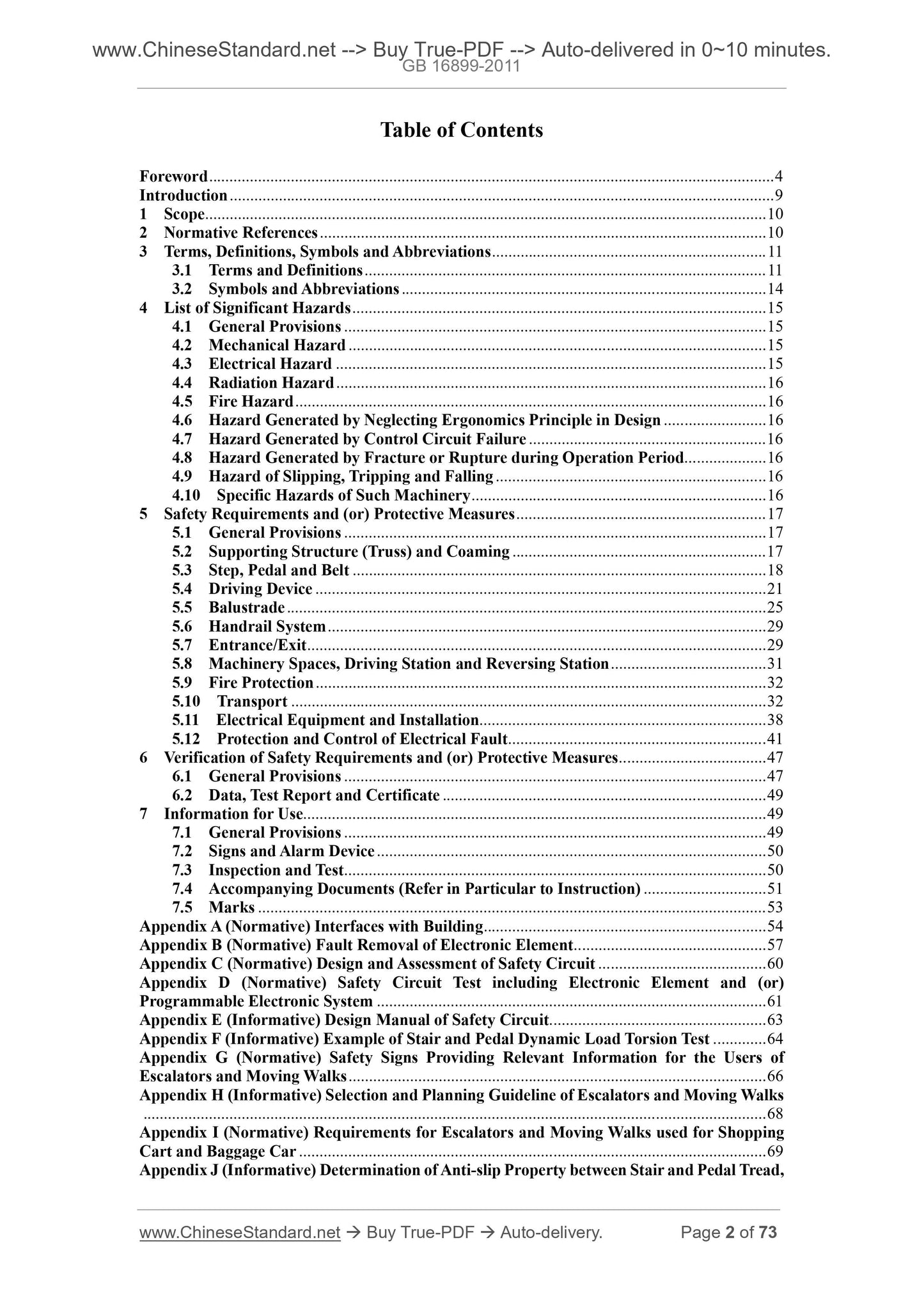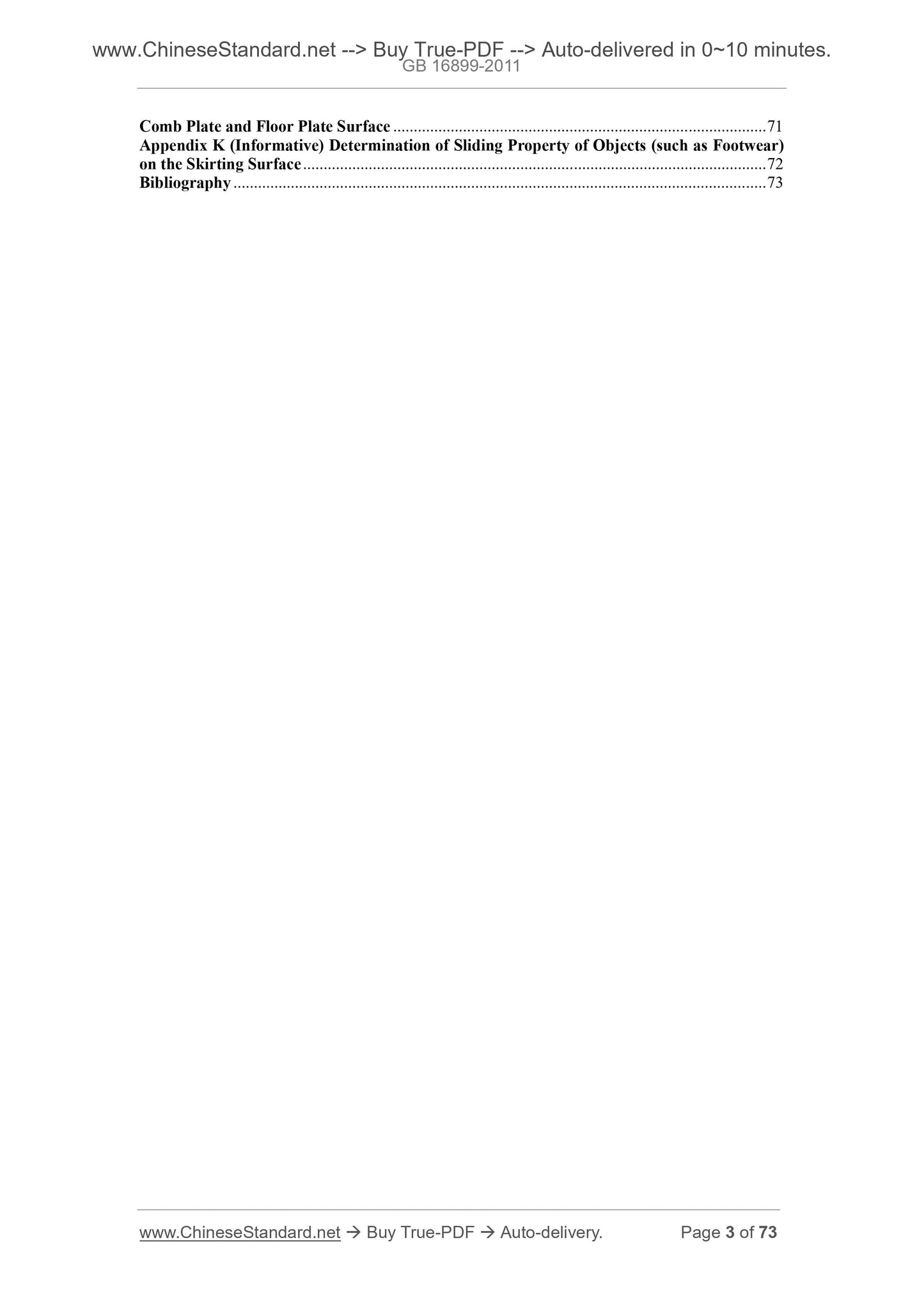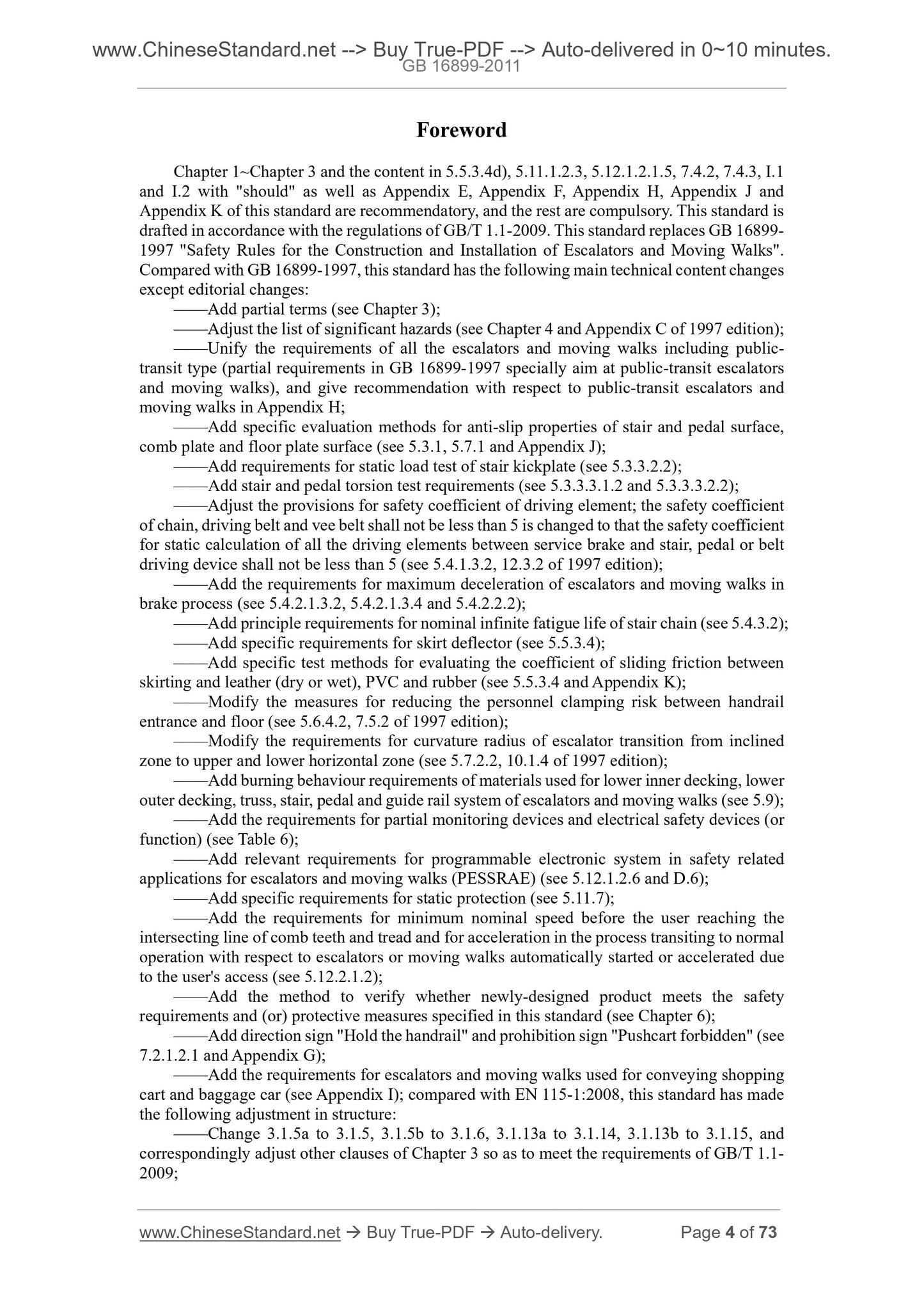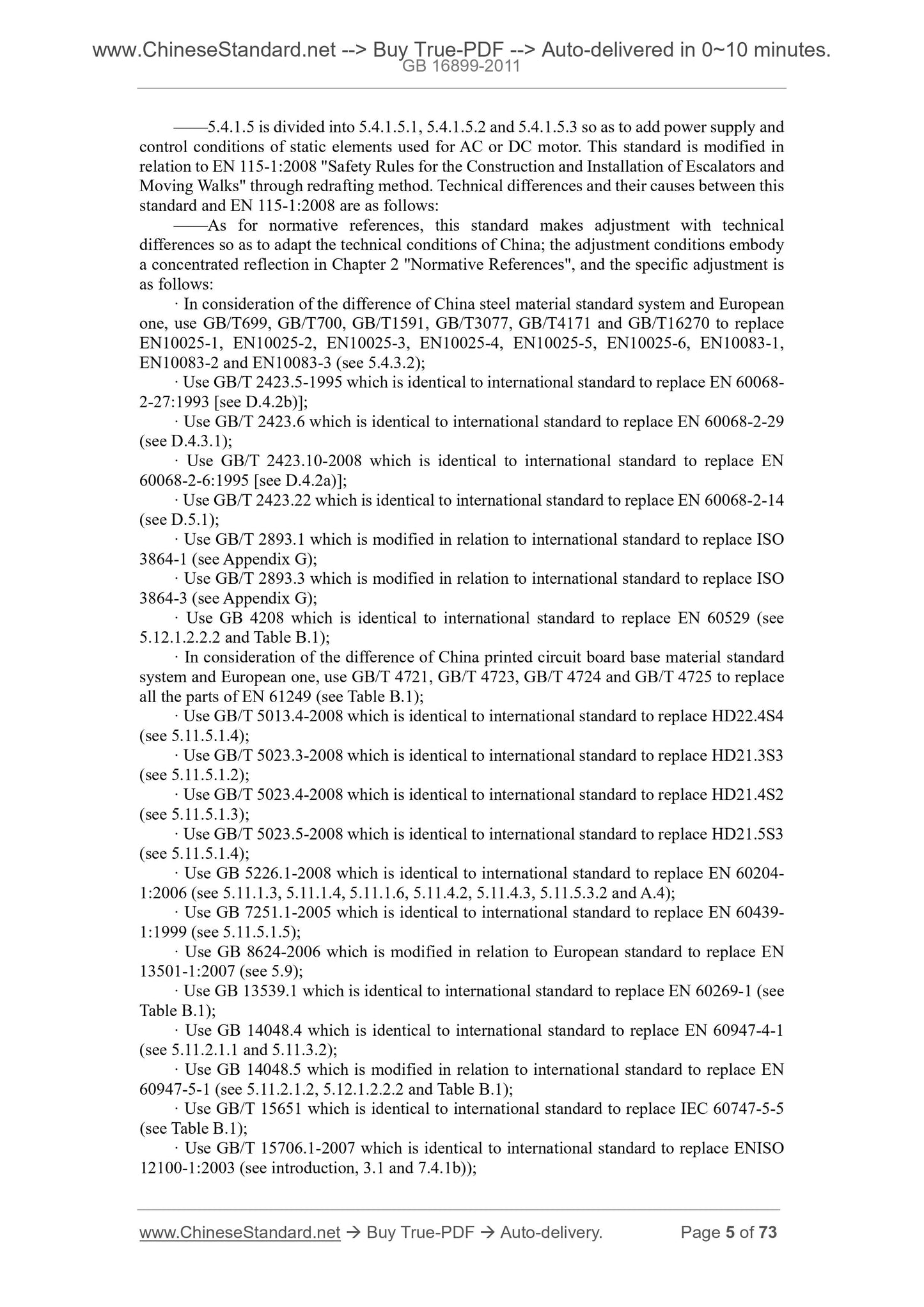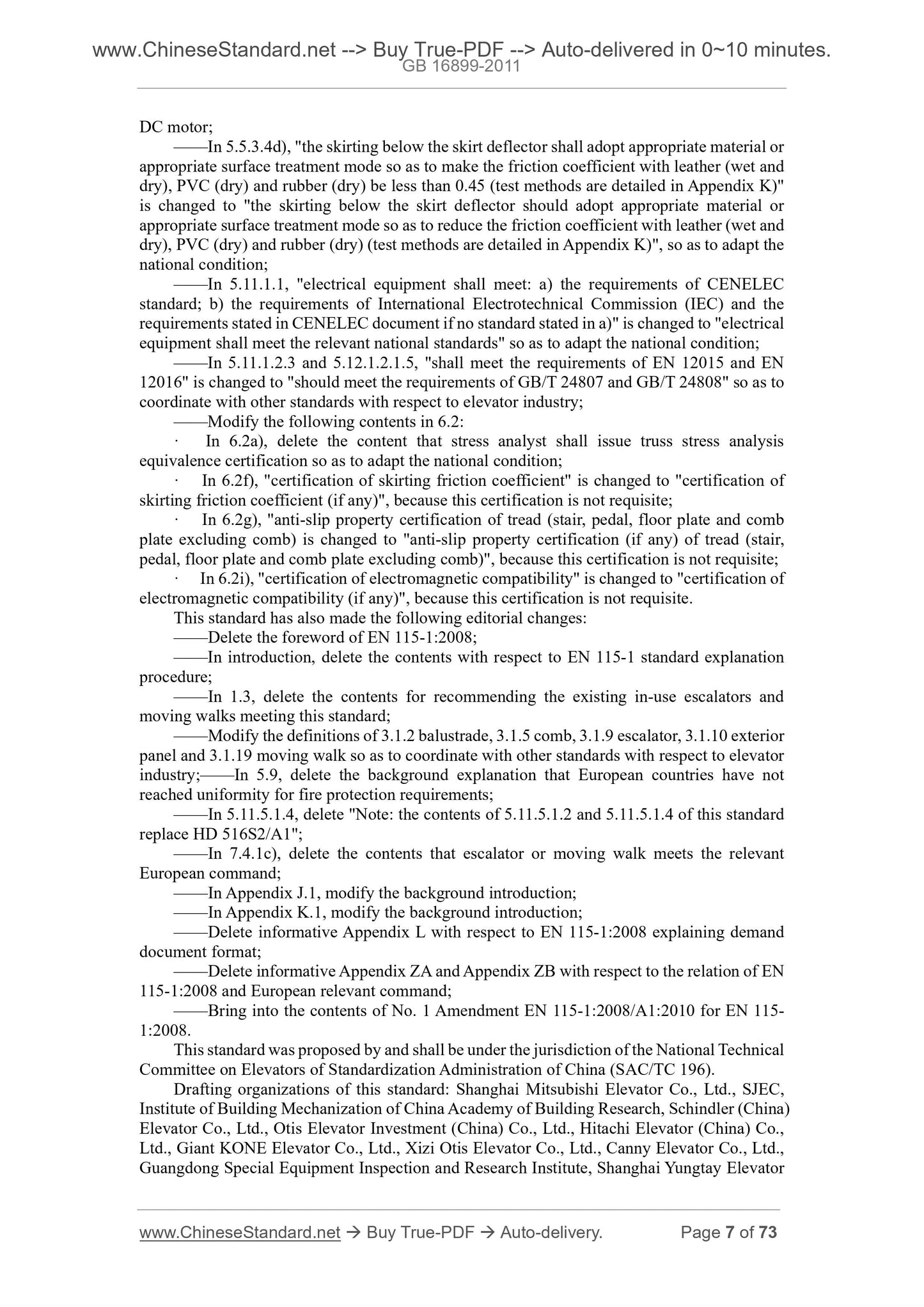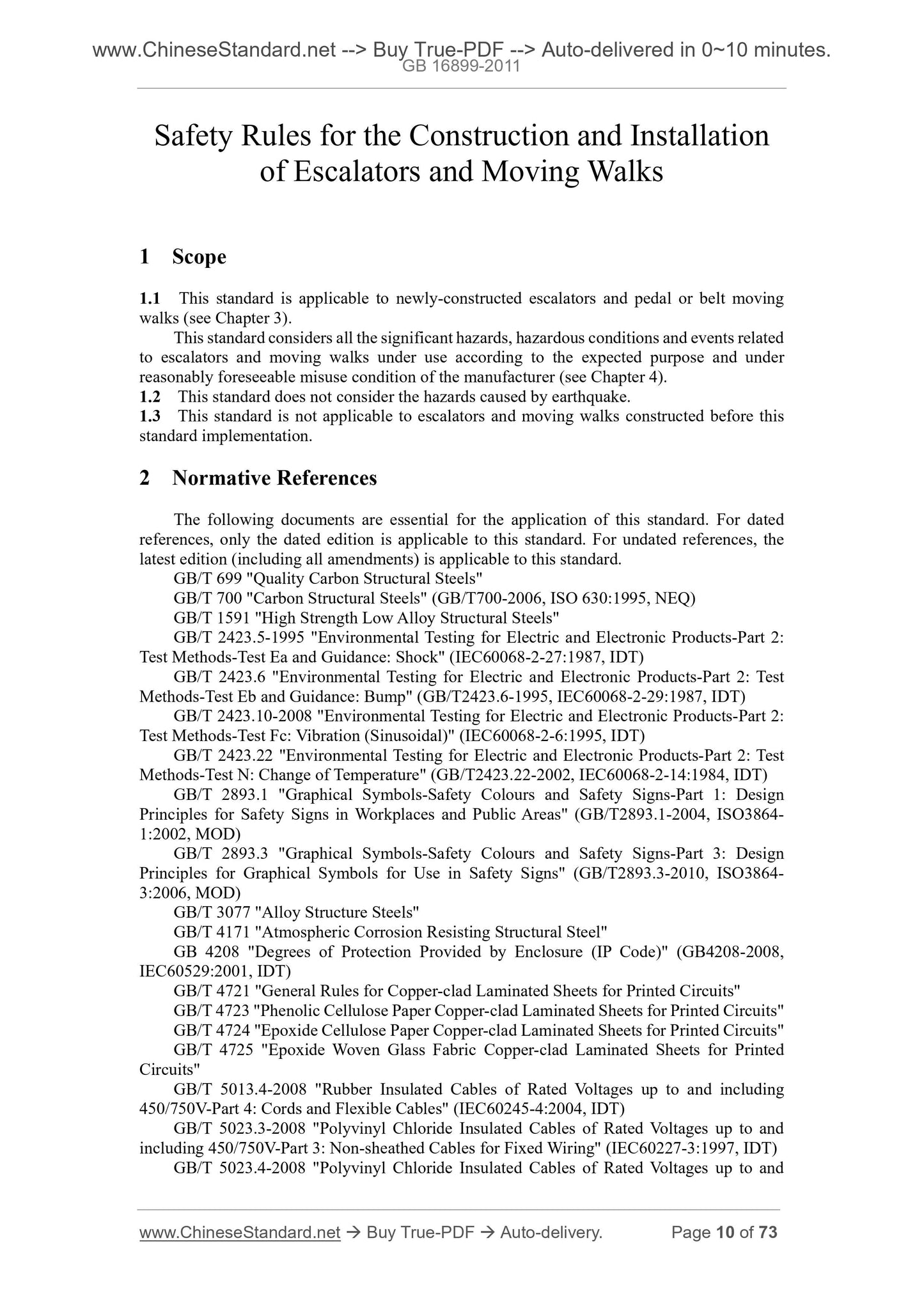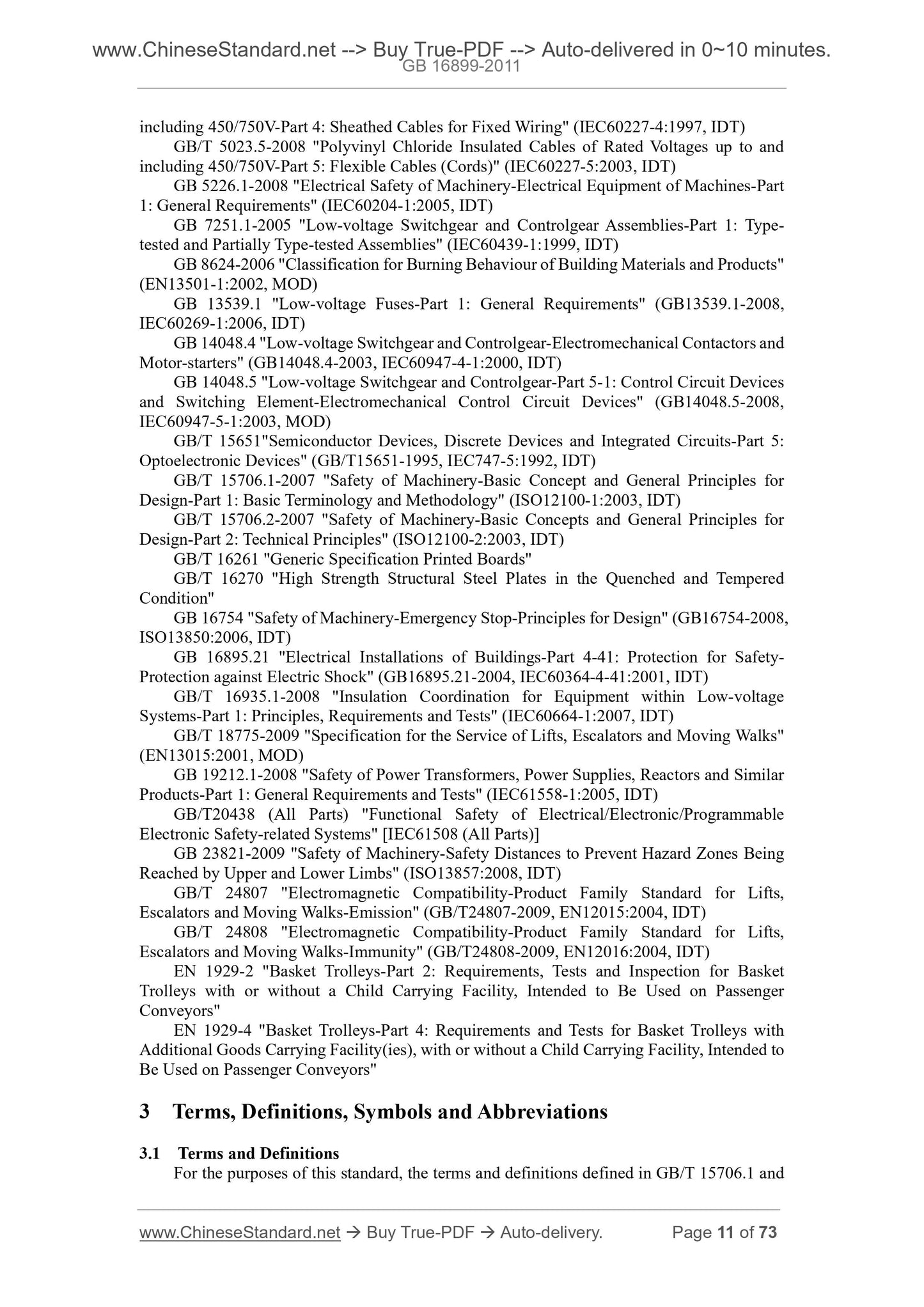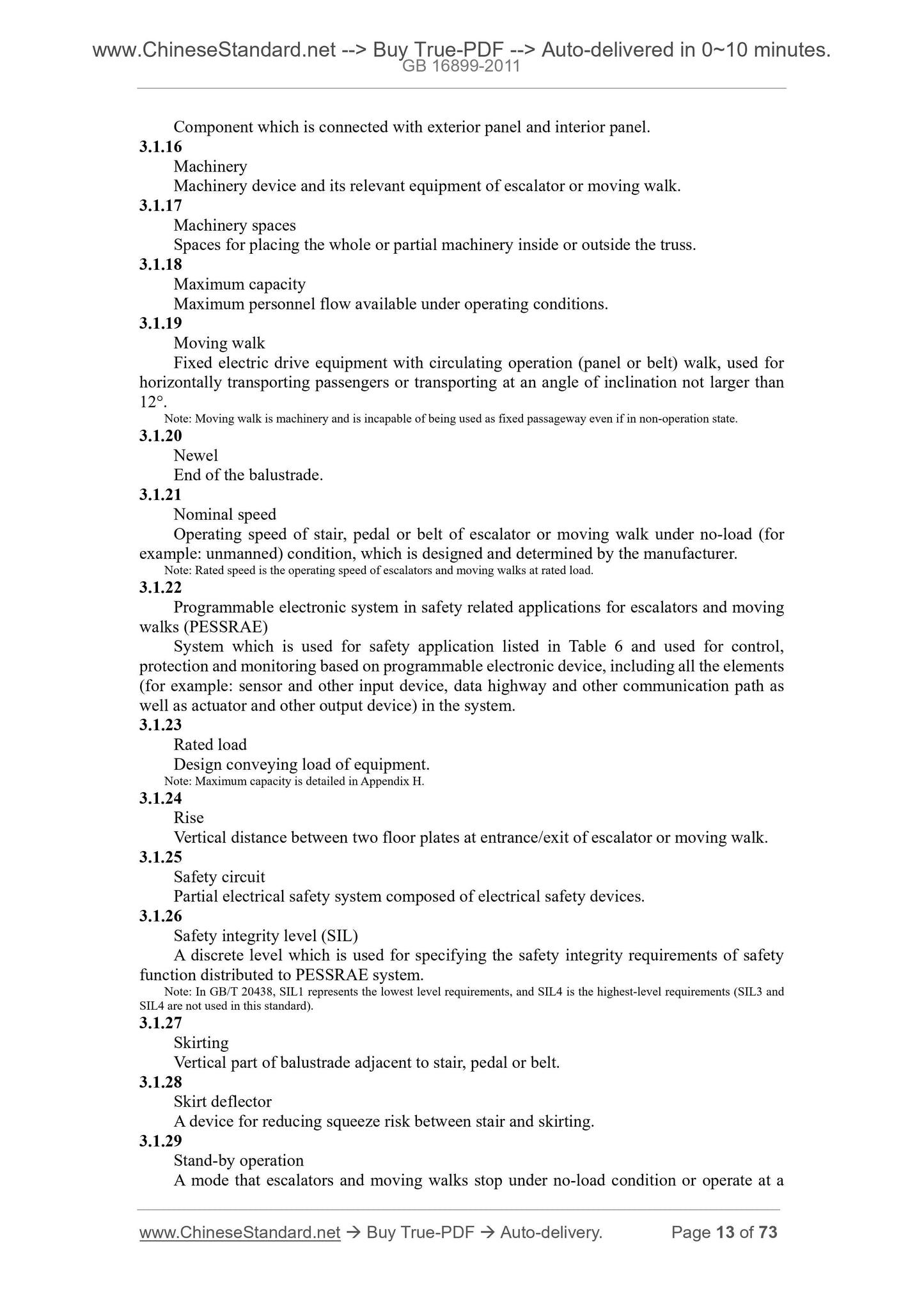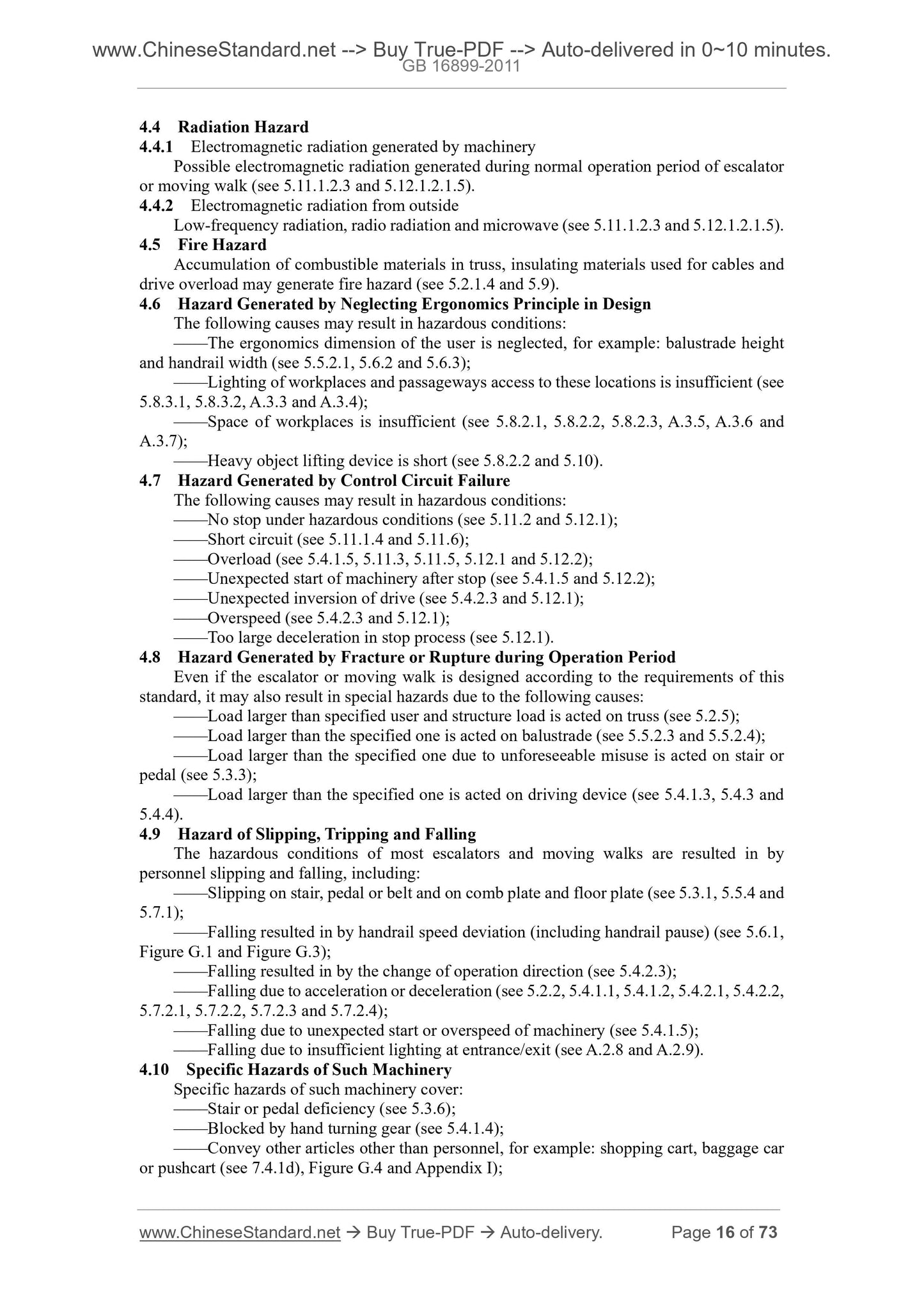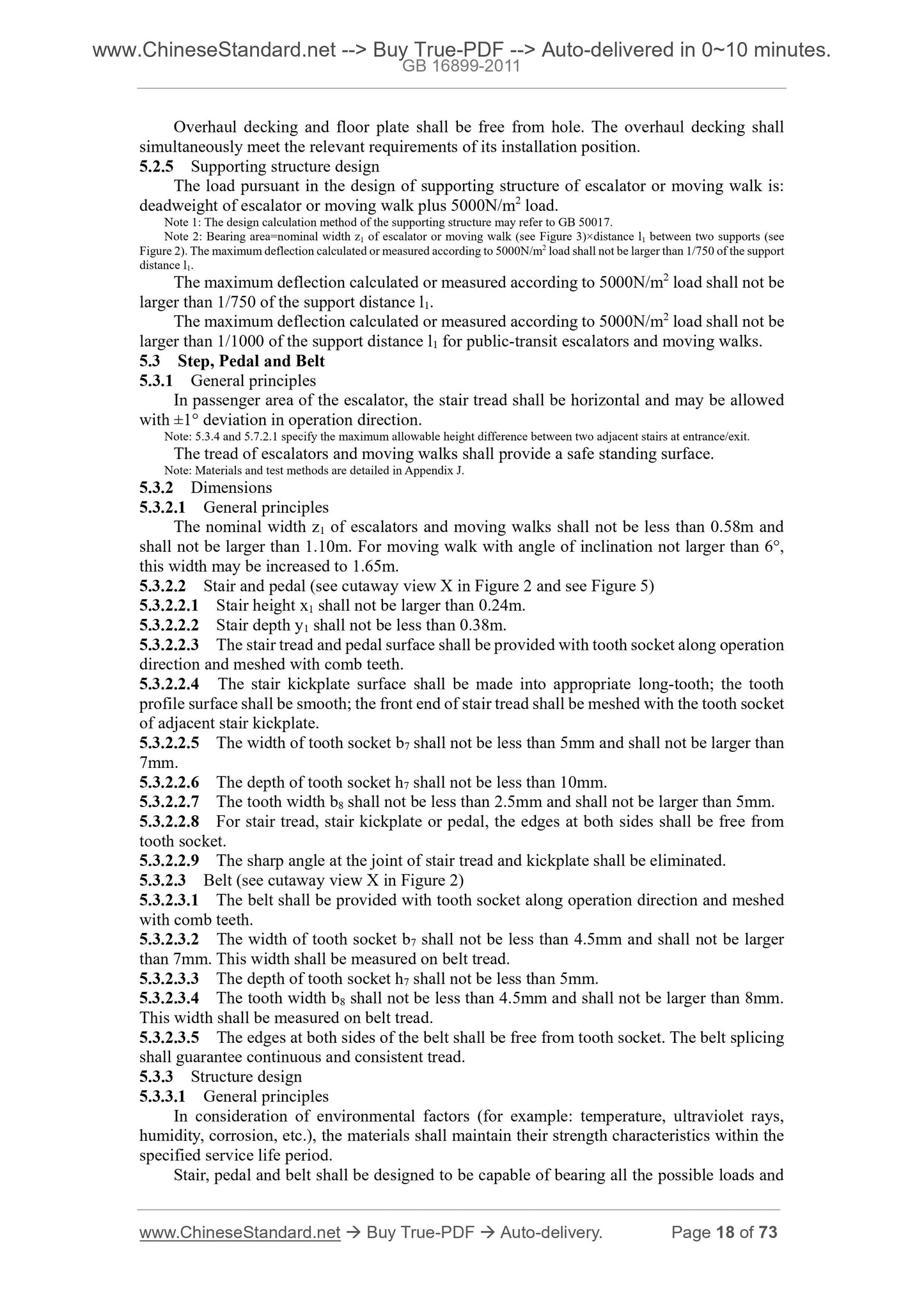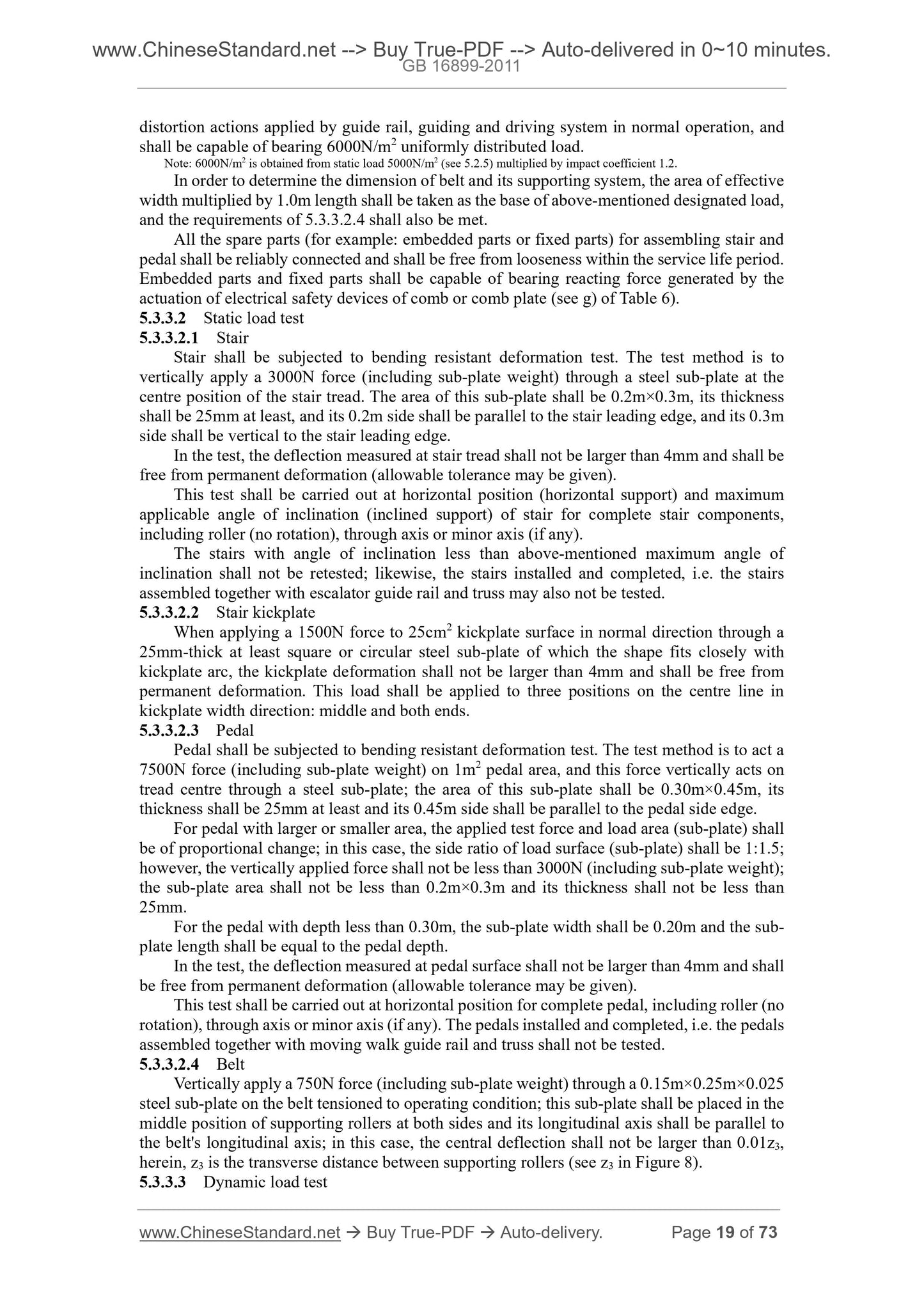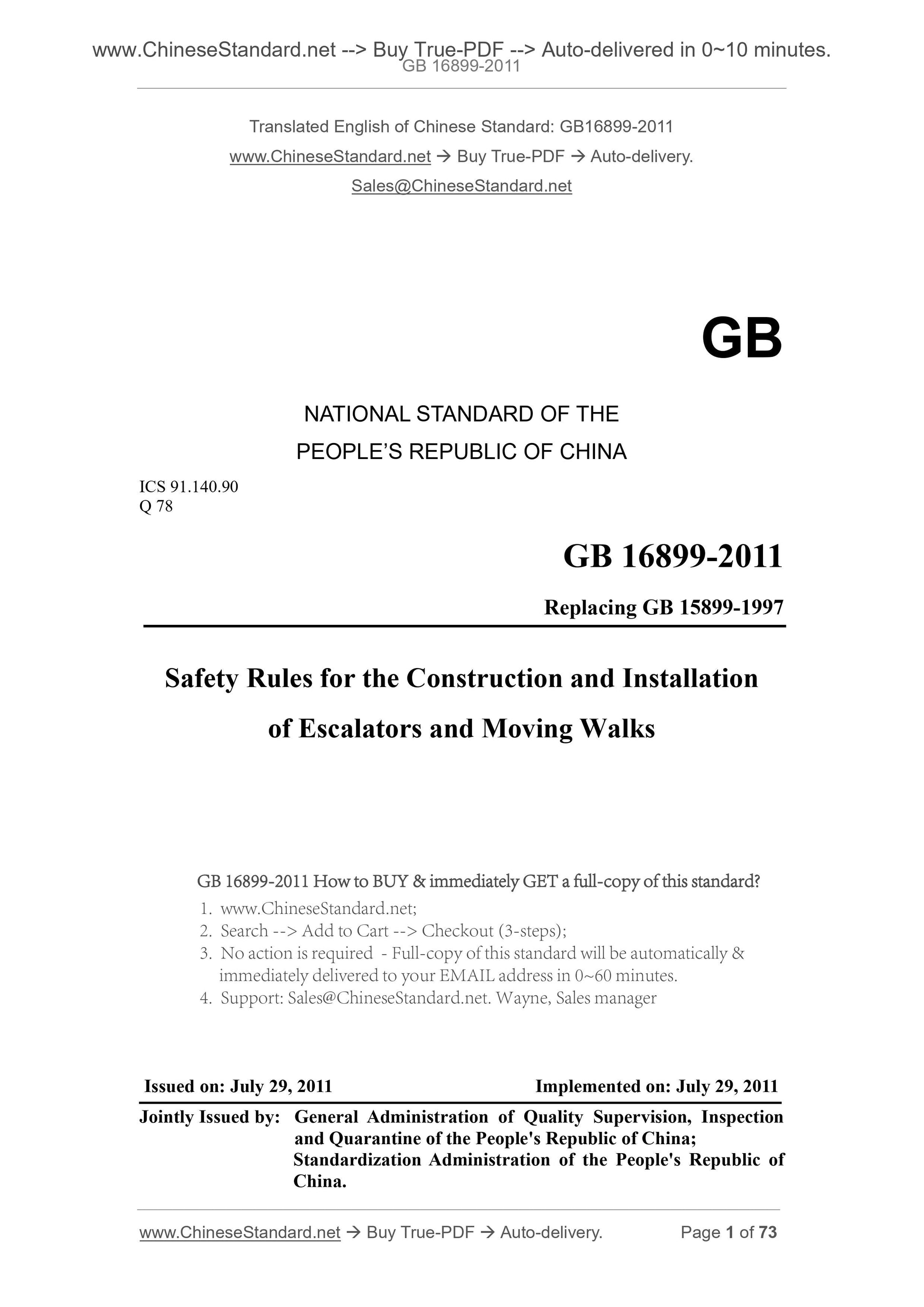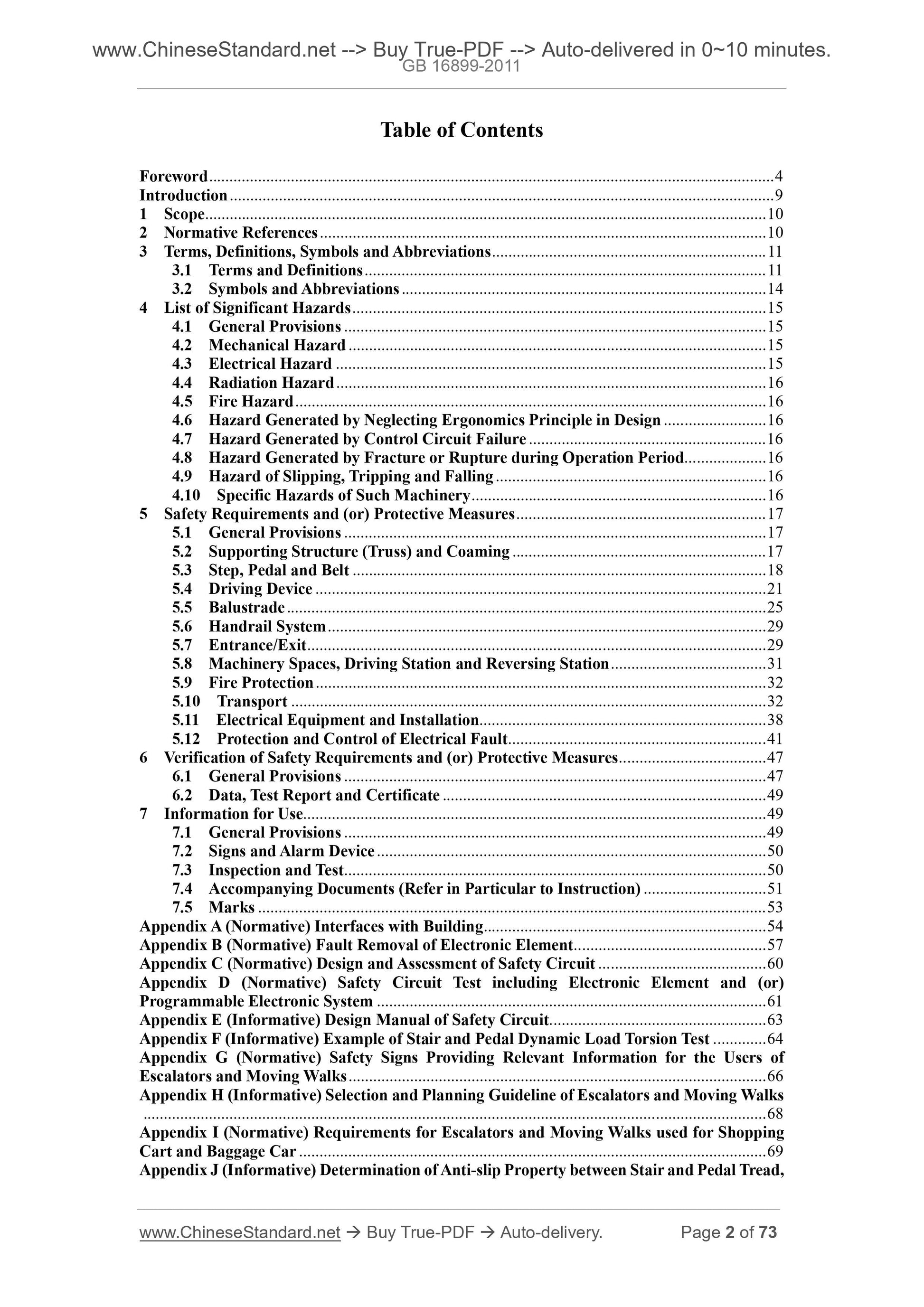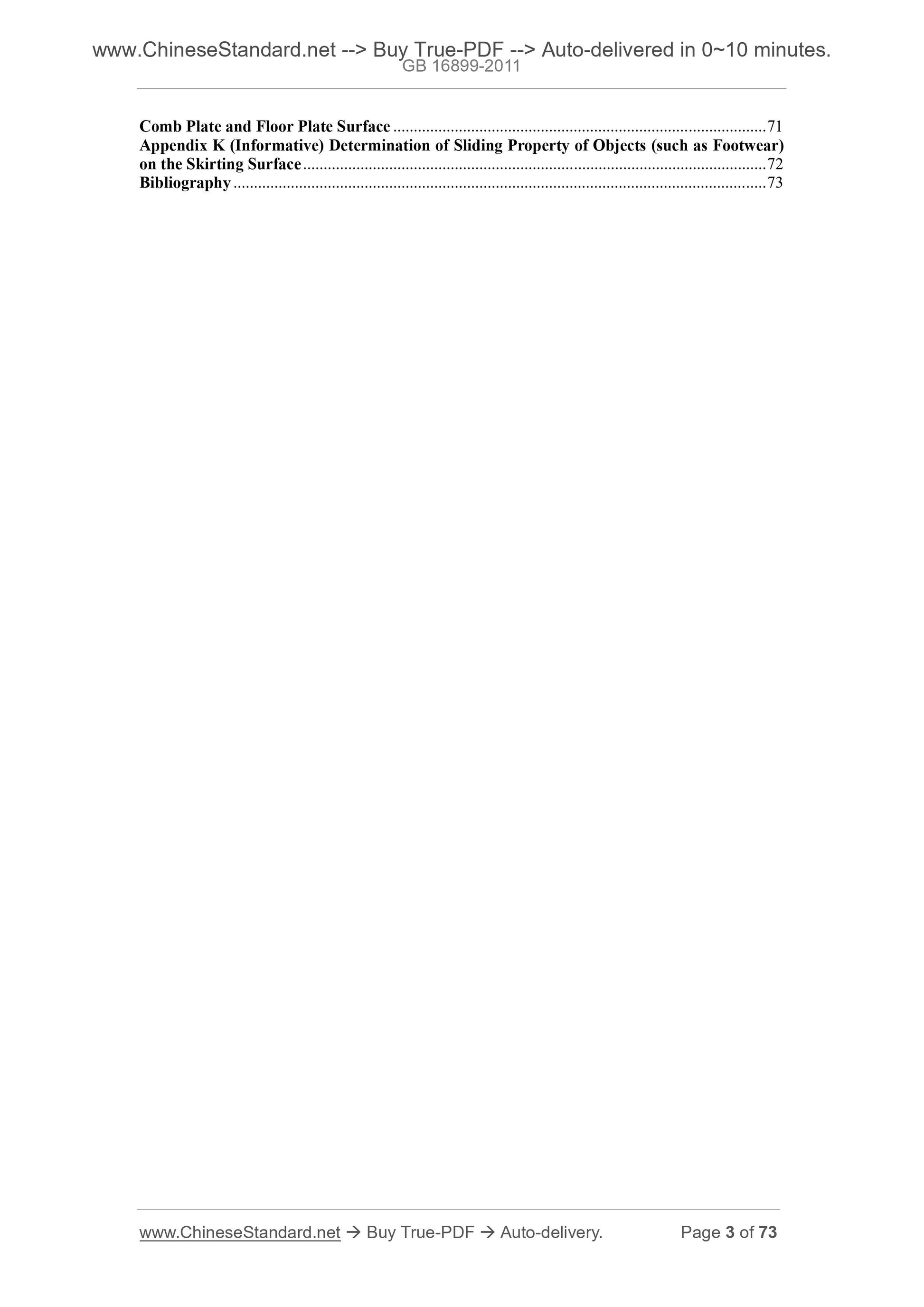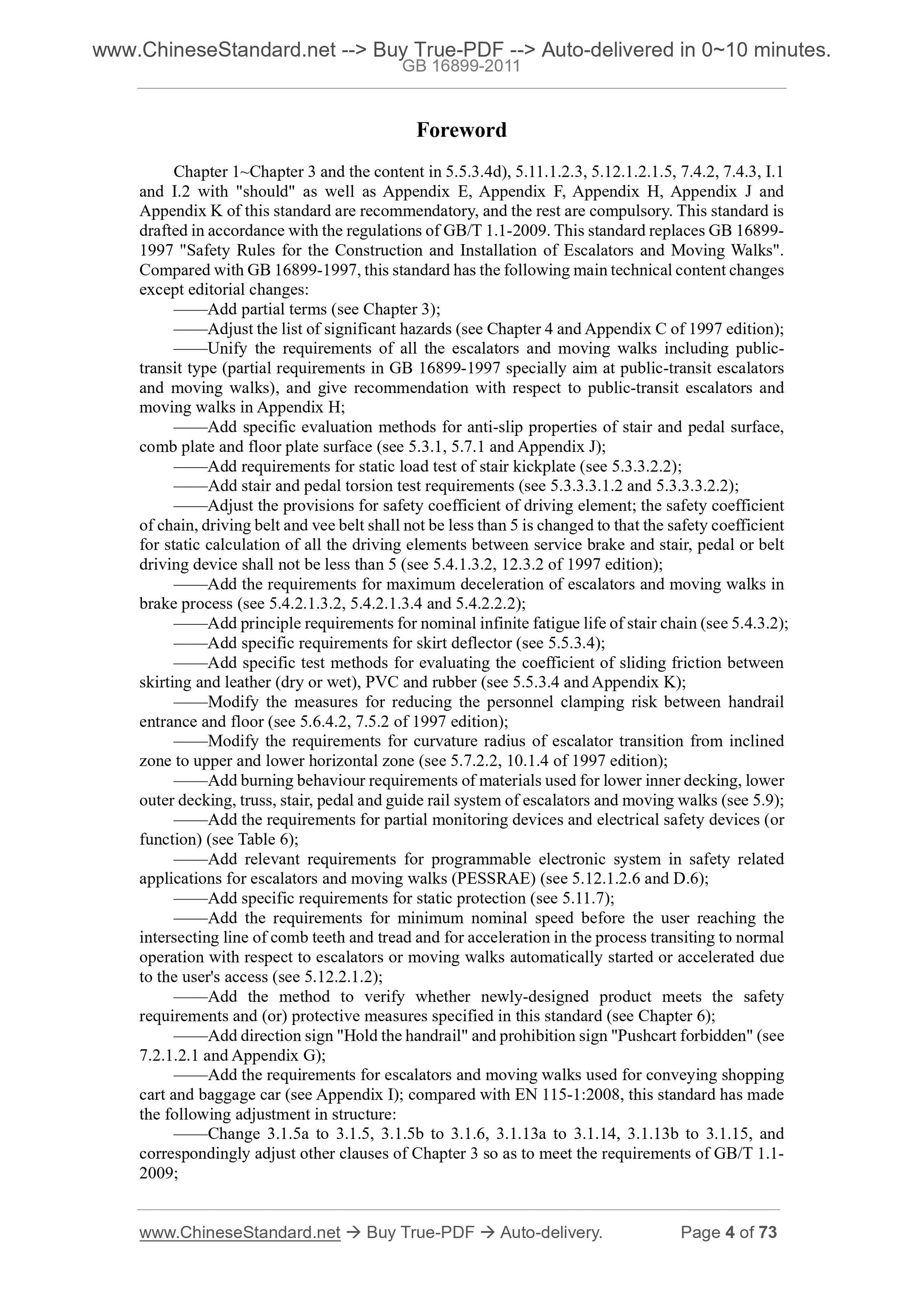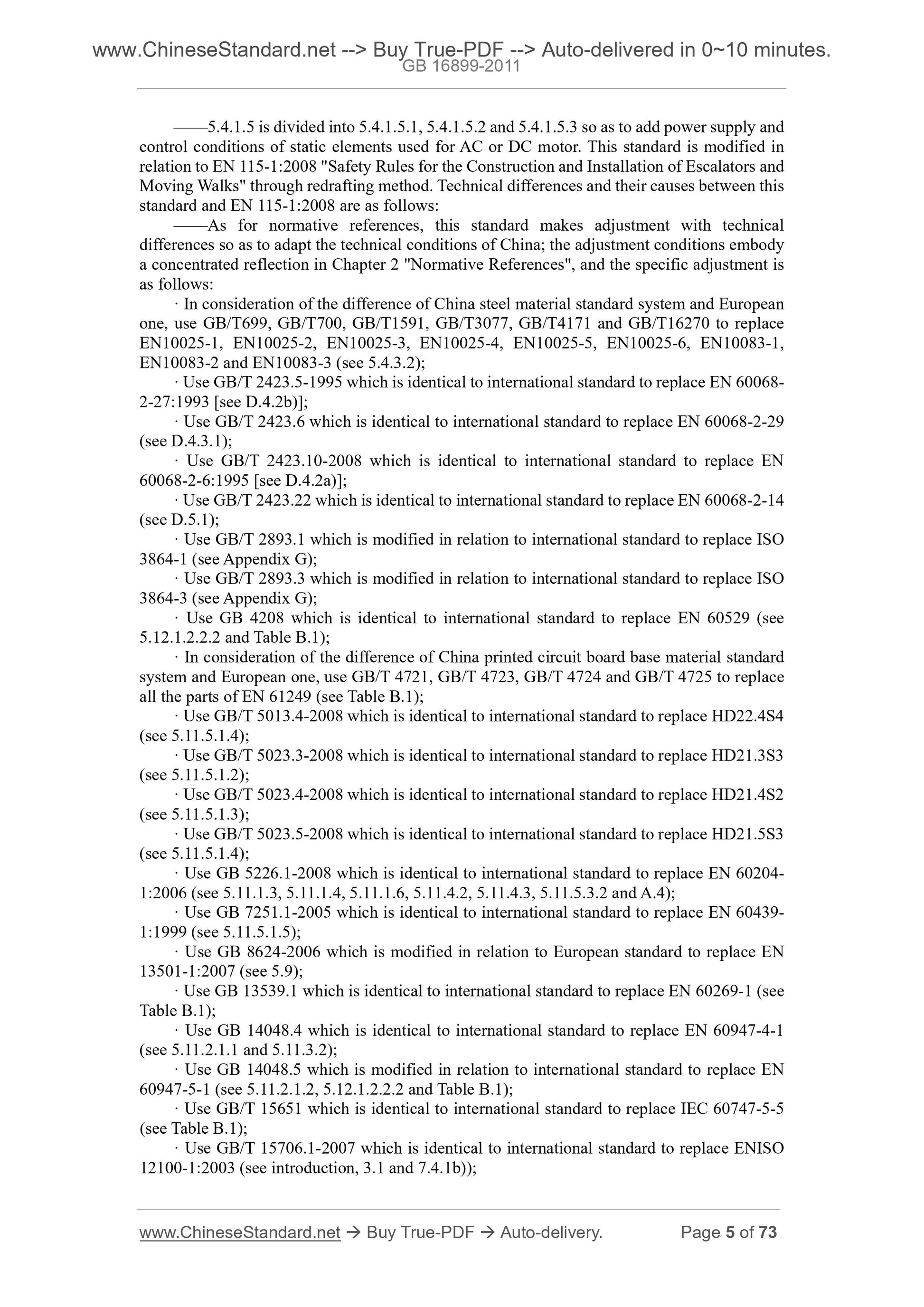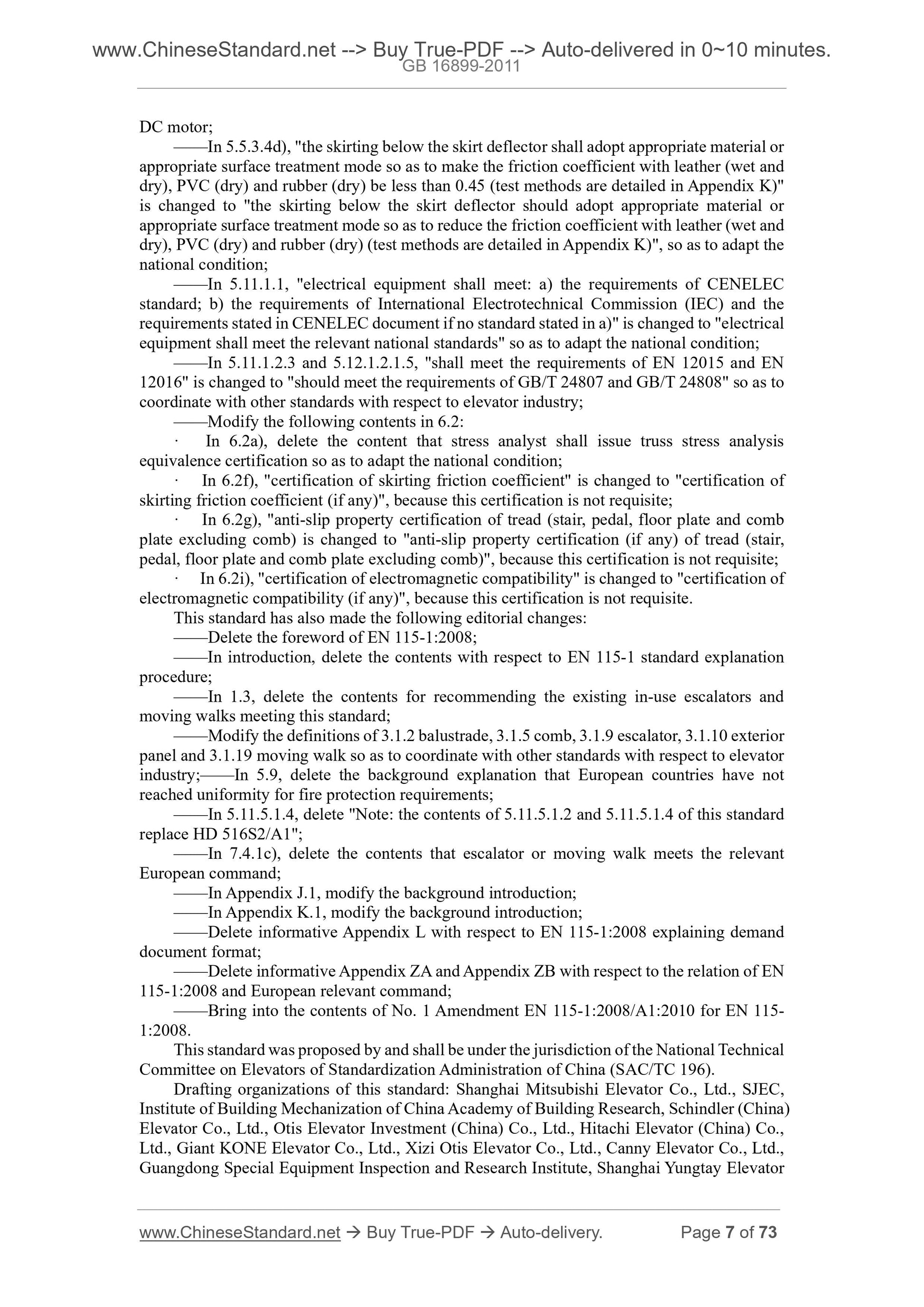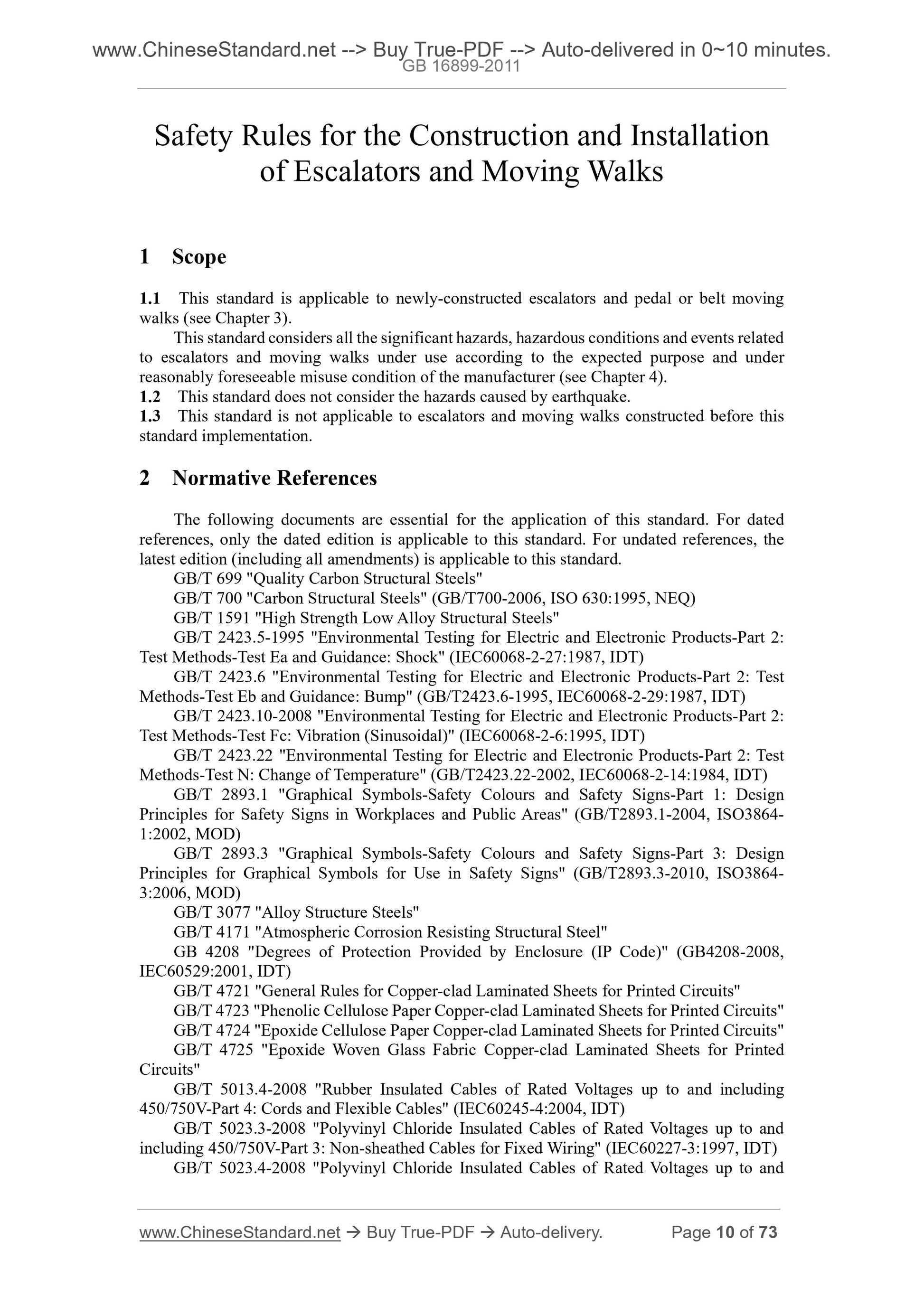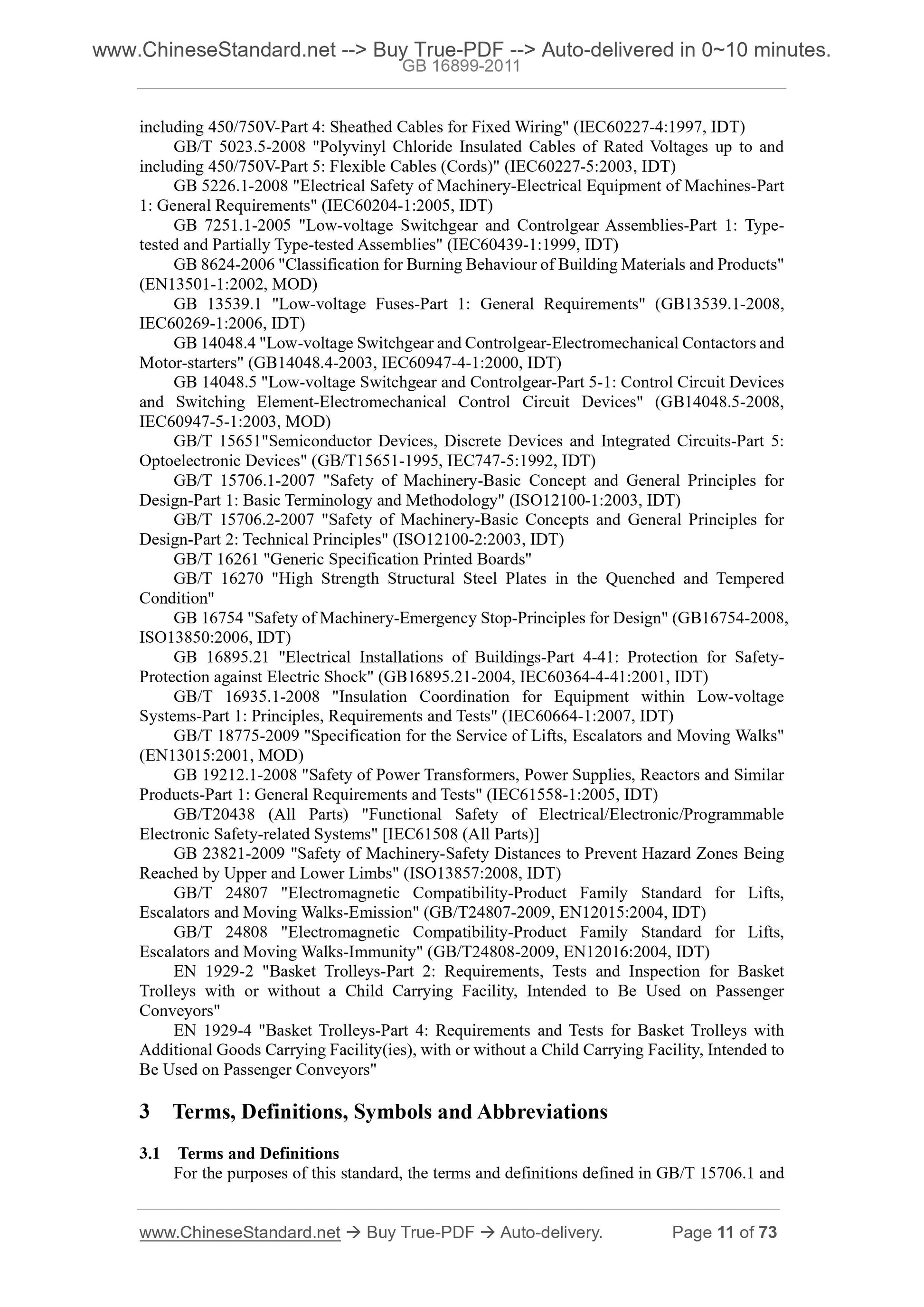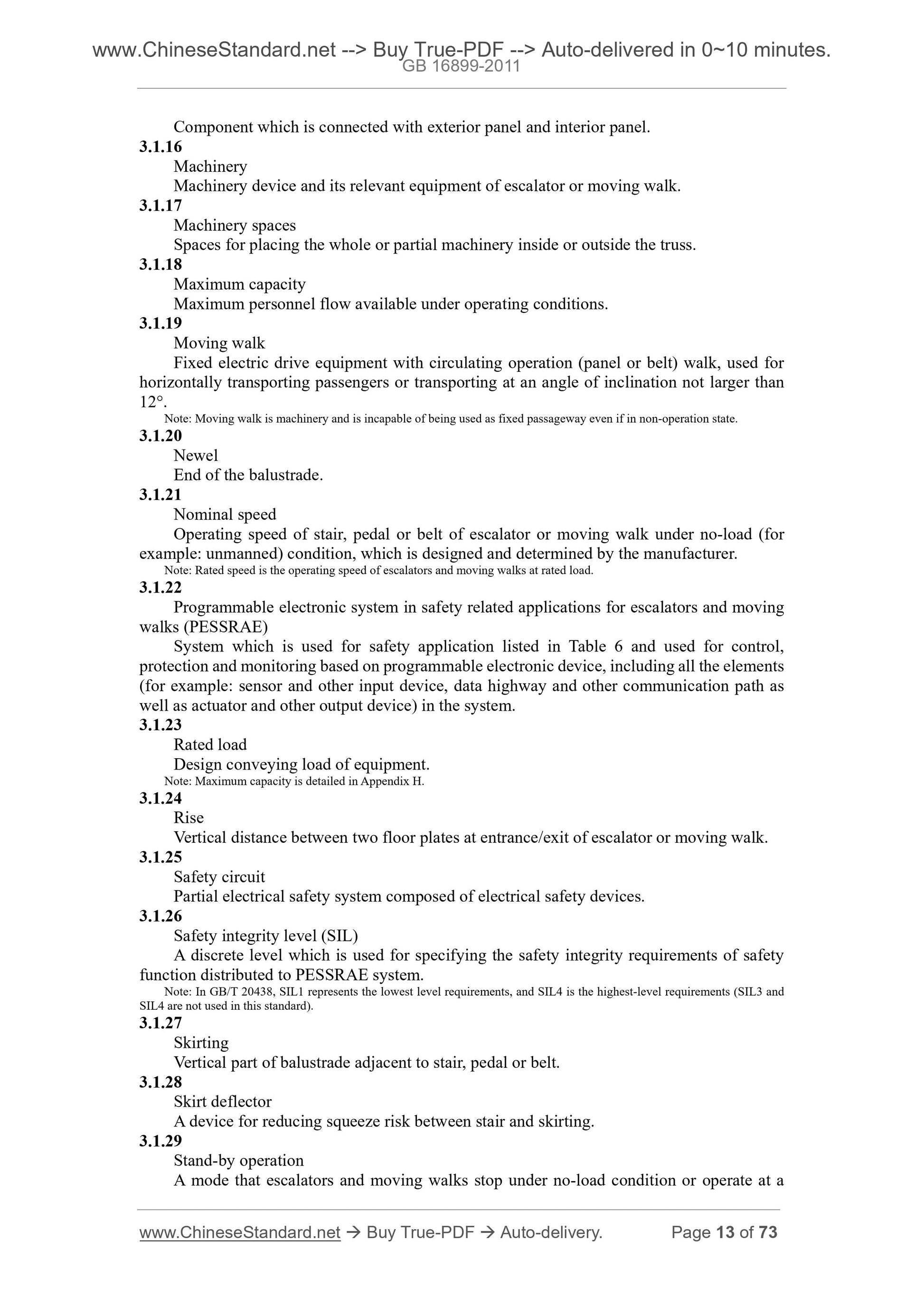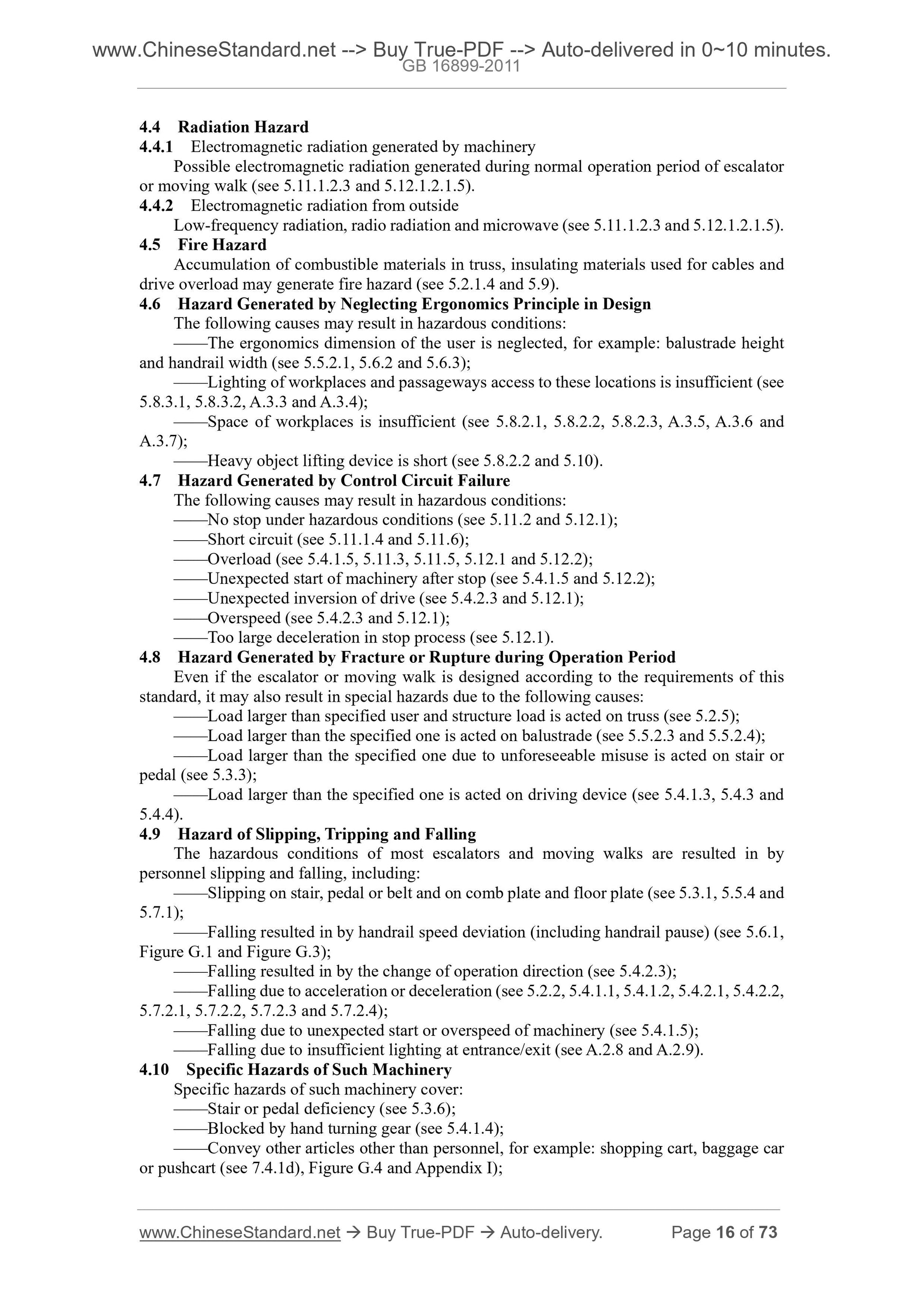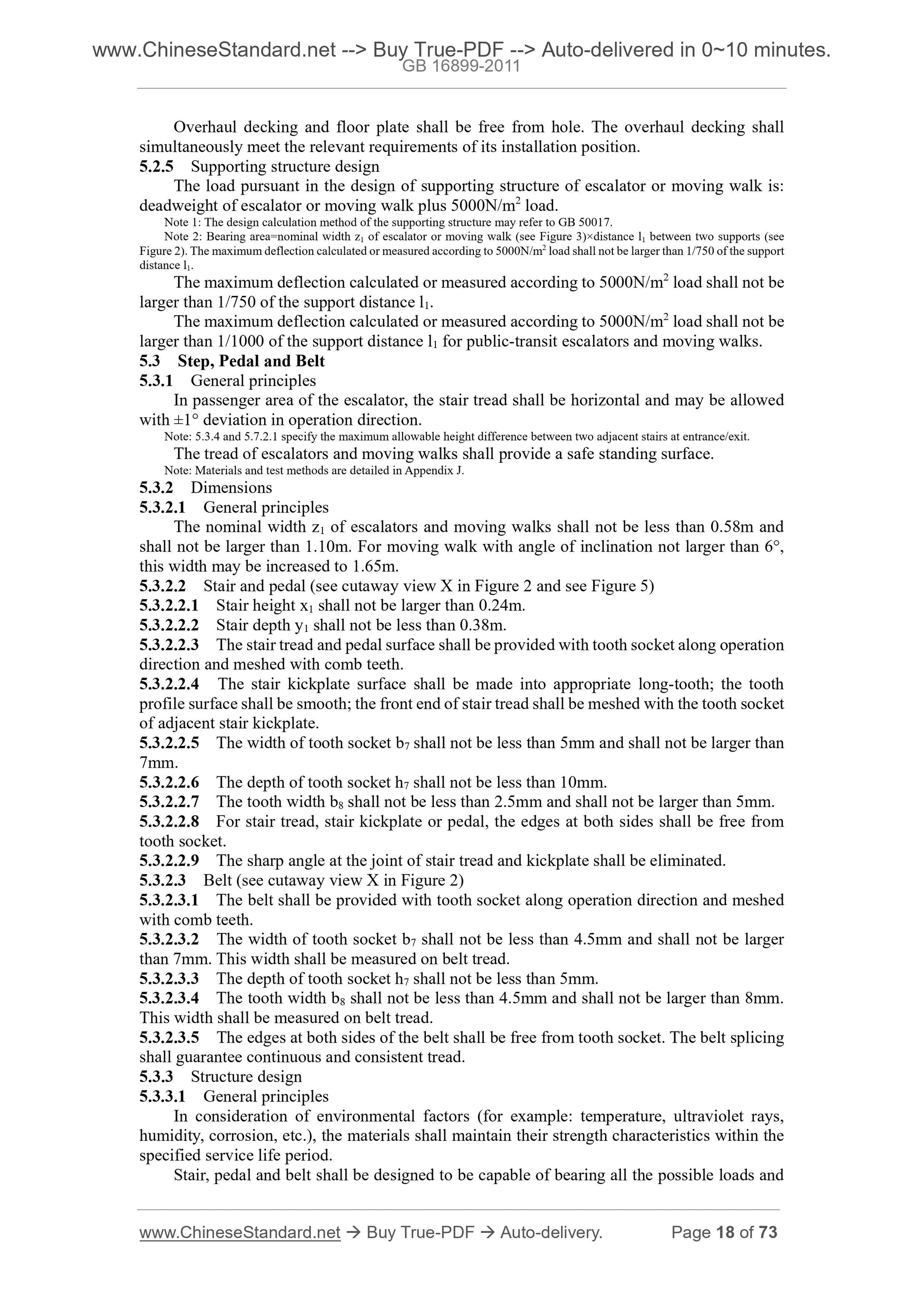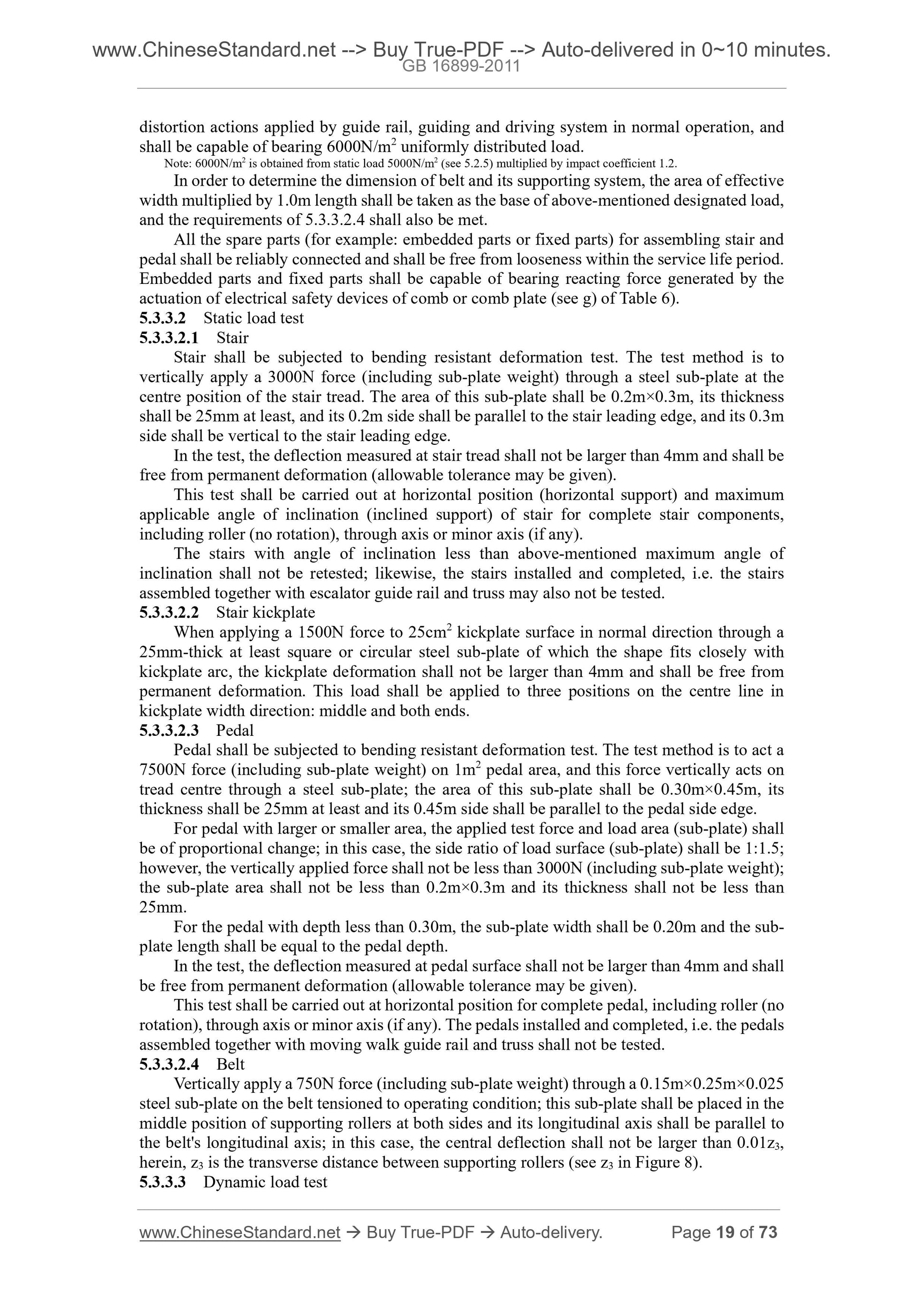1
/
of
12
www.ChineseStandard.us -- Field Test Asia Pte. Ltd.
GB 16899-2011 English PDF
GB 16899-2011 English PDF
Regular price
$145.00
Regular price
Sale price
$145.00
Unit price
/
per
Shipping calculated at checkout.
Couldn't load pickup availability
GB 16899-2011: Safety rules for the construction and installation of escalators and moving walks
Delivery: 9 seconds. Download (& Email) true-PDF + Invoice.
Get Quotation: Click GB 16899-2011 (Self-service in 1-minute)
Historical versions (Master-website): GB 16899-2011
Preview True-PDF (Reload/Scroll-down if blank)
GB 16899-2011
GB
NATIONAL STANDARD OF THE
PEOPLE’S REPUBLIC OF CHINA
ICS 91.140.90
Q 78
Replacing GB 15899-1997
Safety Rules for the Construction and Installation of
Escalators and Moving Walks
ISSUED ON. JULY 29, 2011
IMPLEMENTED ON. JULY 29, 2011
Jointly Issued by. General Administration of Quality Supervision, Inspection
and Quarantine of the People's Republic of China;
Standardization Administration of the People's Republic of
China.
3. No action is required - Full-copy of this standard will be automatically and
immediately delivered to your EMAIL address in 0~60 minutes.
Table of Contents
Foreword ... 4
Introduction ... 9
1 Scope .. 10
2 Normative References ... 10
3 Terms, Definitions, Symbols and Abbreviations ... 11
3.1 Terms and Definitions ... 11
3.2 Symbols and Abbreviations ... 14
4 List of Significant Hazards ... 15
4.1 General Provisions ... 15
4.2 Mechanical Hazard .. 15
4.3 Electrical Hazard .. 15
4.4 Radiation Hazard .. 16
4.5 Fire Hazard ... 16
4.6 Hazard Generated by Neglecting Ergonomics Principle in Design .. 16
4.7 Hazard Generated by Control Circuit Failure ... 16
4.8 Hazard Generated by Fracture or Rupture during Operation Period ... 16
4.9 Hazard of Slipping, Tripping and Falling ... 16
4.10 Specific Hazards of Such Machinery ... 16
5 Safety Requirements and (or) Protective Measures ... 17
5.1 General Provisions ... 17
5.2 Supporting Structure (Truss) and Coaming .. 17
5.3 Step, Pedal and Belt ... 18
5.4 Driving Device ... 21
5.5 Balustrade .. 25
5.6 Handrail System ... 29
5.7 Entrance/Exit ... 29
5.8 Machinery Spaces, Driving Station and Reversing Station ... 31
5.9 Fire Protection ... 32
5.10 Transport ... 32
5.11 Electrical Equipment and Installation ... 38
5.12 Protection and Control of Electrical Fault ... 41
6 Verification of Safety Requirements and (or) Protective Measures ... 47
6.1 General Provisions ... 47
6.2 Data, Test Report and Certificate ... 49
7 Information for Use ... 49
7.1 General Provisions ... 49
7.2 Signs and Alarm Device ... 50
7.3 Inspection and Test ... 50
7.4 Accompanying Documents (Refer in Particular to Instruction) ... 51
7.5 Marks ... 53
Appendix A (Normative) Interfaces with Building ... 54
Appendix B (Normative) Fault Removal of Electronic Element ... 57
Appendix C (Normative) Design and Assessment of Safety Circuit ... 60
Appendix D (Normative) Safety Circuit Test including Electronic Element and (or)
Programmable Electronic System ... 61
Appendix E (Informative) Design Manual of Safety Circuit ... 63
Appendix F (Informative) Example of Stair and Pedal Dynamic Load Torsion Test ... 64
Appendix G (Normative) Safety Signs Providing Relevant Information for the Users of
Escalators and Moving Walks .. 66
Appendix H (Informative) Selection and Planning Guideline of Escalators and Moving Walks
... 68
Appendix I (Normative) Requirements for Escalators and Moving Walks used for Shopping
Cart and Baggage Car .. 69
Appendix J (Informative) Determination of Anti-slip Property between Stair and Pedal Tread,
Comb Plate and Floor Plate Surface .. 71
Appendix K (Informative) Determination of Sliding Property of Objects (such as Footwear)
on the Skirting Surface ... 72
Bibliography ... 73
Foreword
Chapter 1~Chapter 3 and the content in 5.5.3.4d), 5.11.1.2.3, 5.12.1.2.1.5, 7.4.2, 7.4.3, I.1
and I.2 with "should" as well as Appendix E, Appendix F, Appendix H, Appendix J and
Appendix K of this standard are recommendatory, and the rest are compulsory. This standard is
drafted in accordance with the regulations of GB/T 1.1-2009. This standard replaces GB 16899-
1997 "Safety Rules for the Construction and Installation of Escalators and Moving Walks".
Compared with GB 16899-1997, this standard has the following main technical content changes
except editorial changes.
——Add partial terms (see Chapter 3);
——Adjust the list of significant hazards (see Chapter 4 and Appendix C of 1997 edition);
——Unify the requirements of all the escalators and moving walks including public-
transit type (partial requirements in GB 16899-1997 specially aim at public-transit escalators
and moving walks), and give recommendation with respect to public-transit escalators and
moving walks in Appendix H;
——Add specific evaluation methods for anti-slip properties of stair and pedal surface,
comb plate and floor plate surface (see 5.3.1, 5.7.1 and Appendix J);
——Add requirements for static load test of stair kickplate (see 5.3.3.2.2);
——Add stair and pedal torsion test requirements (see 5.3.3.3.1.2 and 5.3.3.3.2.2);
——Adjust the provisions for safety coefficient of driving element; the safety coefficient
of chain, driving belt and vee belt shall not be less than 5 is changed to that the safety coefficient
for static calculation of all the driving elements between service brake and stair, pedal or belt
driving device shall not be less than 5 (see 5.4.1.3.2, 12.3.2 of 1997 edition);
——Add the requirements for maximum deceleration of escalators and moving walks in
brake process (see 5.4.2.1.3.2, 5.4.2.1.3.4 and 5.4.2.2.2);
——Add principle requirements for nominal infinite fatigue life of stair chain (see 5.4.3.2);
——Add specific requirements for skirt deflector (see 5.5.3.4);
——Add specific test methods for evaluating the coefficient of sliding friction between
skirting and leather (dry or wet), PVC and rubber (see 5.5.3.4 and Appendix K);
——Modify the measures for reducing the personnel clamping risk between handrail
entrance and floor (see 5.6.4.2, 7.5.2 of 1997 edition);
——Modify the requirements for curvature radius of escalator transition from inclined
zone to upper and lower horizontal zone (see 5.7.2.2, 10.1.4 of 1997 edition);
——Add burning behaviour requirements of materials used for lower inner decking, lower
outer decking, truss, stair, pedal and guide rail system of escalators and moving walks (see 5.9);
——Add the requirements for partial monitoring devices and electrical safety devices (or
function) (see Table 6);
——Add relevant requirements for programmable electronic system in safety related
applications for escalators and moving walks (PESSRAE) (see 5.12.1.2.6 and D.6);
——Add specific requirements for static protection (see 5.11.7);
——Add the requirements for minimum nominal speed before the user reaching the
intersecting line of comb teeth and tread and for acceleration in the process transiting to normal
operation with respect to escalators or moving walks automatically started or accelerated due
to the user's access (see 5.12.2.1.2);
——Add the method to verify whether newly-designed product meets the safety
requirements and (or) protective measures specified in this standard (see Chapter 6);
——Add direction sign "Hold the handrail" and prohibition sign "Pushcart forbidden" (see
7.2.1.2.1 and Appendix G);
——Add the requirements for escalators and moving walks used for conveying shopping
cart and baggage car (see Appendix I); compared with EN 115-1.2008, this standard has made
the following adjustment in structure.
——Change 3.1.5a to 3.1.5, 3.1.5b to 3.1.6, 3.1.13a to 3.1.14, 3.1.13b to 3.1.15, and
correspondingly adjust other clauses of Chapter 3 so as to meet the requirements of GB/T 1.1-
2009;
——5.4.1.5 is divided into 5.4.1.5.1, 5.4.1.5.2 and 5.4.1.5.3 so as to add power supply and
control conditions of static elements used for AC or DC motor. This standard is modified in
relation to EN 115-1.2008 "Safety Rules for the Construction and Installation of Escalators and
Moving Walks" through redrafting method. Technical differences and their causes between this
standard and EN 115-1.2008 are as follows.
——As for normative references, this standard makes adjustment with technical
differences so as to adapt the technical conditions of China; the adjustment conditions embody
a concentrated reflection in Chapter 2 "Normative References", and the specific adjustment is
as follows.
· In consideration of the difference of China steel material standard system and European
one, use GB/T699, GB/T700, GB/T1591, GB/T3077, GB/T4171 and GB/T16270 to replace
EN10025-1, EN10025-2, EN10025-3, EN10025-4, EN10025-5, EN10025-6, EN10083-1,
EN10083-2 and EN10083-3 (see 5.4.3.2);
· Use GB/T 2423.5-1995 which is identical to international standard to replace EN 60068-
2-27.1993 [see D.4.2b)];
· Use GB/T 2423.6 which is identical to international standard to replace EN 60068-2-29
(see D.4.3.1);
· Use GB/T 2423.10-2008 which is identical to international standard to replace EN
60068-2-6.1995 [see D.4.2a)];
· Use GB/T 2423.22 which is identical to international standard to replace EN 60068-2-14
(see D.5.1);
· Use GB/T 2893.1 which is modified in relation to international standard to replace ISO
3864-1 (see Appendix G);
· Use GB/T 2893.3 which is modified in relation to international standard to replace ISO
3864-3 (see Appendix G);
· Use GB 4208 which is identical to international standard to replace EN 60529 (see
5.12.1.2.2.2 and Table B.1);
· In consideration of the difference of China printed circuit board base material standard
system and European one, use GB/T 4721, GB/T 4723, GB/T 4724 and GB/T 4725 to replace
all the parts of EN 61249 (see Table B.1);
· Use GB/T 5013.4-2008 which is identical to international standard to replace HD22.4S4
(see 5.11.5.1.4);
· Use GB/T 5023.3-2008 which is identical to international standard to replace HD21.3S3
(see 5.11.5.1.2);
· Use GB/T 5023.4-2008 which is identical to international standard to replace HD21.4S2
(see 5.11.5.1.3);
· Use GB/T 5023.5-2008 which is identical to international standard to replace HD21.5S3
(see 5.11.5.1.4);
· Use GB 5226.1-2008 which is identical to international standard to replace EN 60204-
1.2006 (see 5.11.1.3, 5.11.1.4, 5.11.1.6, 5.11.4.2, 5.11.4.3, 5.11.5.3.2 and A.4);
· Use GB 7251.1-2005 which is identical to international standard to replace EN 60439-
1.1999 (see 5.11.5.1.5);
· Use GB 8624-2006 which is modified in relation to European standard to replace EN
13501-1.2007 (see 5.9);
· Use GB 13539.1 which is identical to international standard to replace EN 60269-1 (see
Table B.1);
· Use GB 14048.4 which is identical to international standard to replace EN 60947-4-1
(see 5.11.2.1.1 and 5.11.3.2);
· Use GB 14048.5 which is modified in relation to international standard to replace EN
60947-5-1 (see 5.11.2.1.2, 5.12.1.2.2.2 and Table B.1);
· Use GB/T 15651 which is identical to international standard to replace IEC 60747-5-5
(see Table B.1);
· Use GB/T 15706.1-2007 which is identical to international standard to replace ENISO
12100-1.2003 (see introduction, 3.1 and 7.4.1b));
DC motor;
——In 5.5.3.4d), "the skirting below the skirt deflector shall adopt appropriate material or
appropriate surface treatment mode so as to make the friction coefficient with leather (wet and
dry), PVC (dry) and rubber (dry) be less than 0.45 (test methods are detailed in Appendix K)"
is changed to "the skirting below the skirt deflector should adopt appropriate material or
appropriate surface treatment mode so as to reduce the friction coefficient with leather (wet and
dry), PVC (dry) and rubber (dry) (test methods are detailed in Appendix K)", so as to adapt the
national condition;
——In 5.11.1.1, "electrical equipment shall meet. a) the requirements of CENELEC
standard; b) the requirements of International Electrotechnical Commission (IEC) and the
requirements stated in CENELEC document if no standard stated in a)" is changed to "electrical
equipment shall meet the relevant national standards" so as to ...
GB 16899-2011
GB
NATIONAL STANDARD OF THE
PEOPLE’S REPUBLIC OF CHINA
ICS 91.140.90
Q 78
Replacing GB 15899-1997
Safety Rules for the Construction and Installation of
Escalators and Moving Walks
ISSUED ON. JULY 29, 2011
IMPLEMENTED ON. JULY 29, 2011
Jointly Issued by. General Administration of Quality Supervision, Inspection
and Quarantine of the People's Republic of China;
Standardization Administration of the People's Republic of
China.
3. No action is required - Full-copy of this standard will be automatically and
immediately delivered to your EMAIL address in 0~60 minutes.
Table of Contents
Foreword ... 4
Introduction ... 9
1 Scope .. 10
2 Normative References ... 10
3 Terms, Definitions, Symbols and Abbreviations ... 11
3.1 Terms and Definitions ... 11
3.2 Symbols and Abbreviations ... 14
4 List of Significant Hazards ... 15
4.1 General Provisions ... 15
4.2 Mechanical Hazard .. 15
4.3 Electrical Hazard .. 15
4.4 Radiation Hazard .. 16
4.5 Fire Hazard ... 16
4.6 Hazard Generated by Neglecting Ergonomics Principle in Design .. 16
4.7 Hazard Generated by Control Circuit Failure ... 16
4.8 Hazard Generated by Fracture or Rupture during Operation Period ... 16
4.9 Hazard of Slipping, Tripping and Falling ... 16
4.10 Specific Hazards of Such Machinery ... 16
5 Safety Requirements and (or) Protective Measures ... 17
5.1 General Provisions ... 17
5.2 Supporting Structure (Truss) and Coaming .. 17
5.3 Step, Pedal and Belt ... 18
5.4 Driving Device ... 21
5.5 Balustrade .. 25
5.6 Handrail System ... 29
5.7 Entrance/Exit ... 29
5.8 Machinery Spaces, Driving Station and Reversing Station ... 31
5.9 Fire Protection ... 32
5.10 Transport ... 32
5.11 Electrical Equipment and Installation ... 38
5.12 Protection and Control of Electrical Fault ... 41
6 Verification of Safety Requirements and (or) Protective Measures ... 47
6.1 General Provisions ... 47
6.2 Data, Test Report and Certificate ... 49
7 Information for Use ... 49
7.1 General Provisions ... 49
7.2 Signs and Alarm Device ... 50
7.3 Inspection and Test ... 50
7.4 Accompanying Documents (Refer in Particular to Instruction) ... 51
7.5 Marks ... 53
Appendix A (Normative) Interfaces with Building...
Delivery: 9 seconds. Download (& Email) true-PDF + Invoice.
Get Quotation: Click GB 16899-2011 (Self-service in 1-minute)
Historical versions (Master-website): GB 16899-2011
Preview True-PDF (Reload/Scroll-down if blank)
GB 16899-2011
GB
NATIONAL STANDARD OF THE
PEOPLE’S REPUBLIC OF CHINA
ICS 91.140.90
Q 78
Replacing GB 15899-1997
Safety Rules for the Construction and Installation of
Escalators and Moving Walks
ISSUED ON. JULY 29, 2011
IMPLEMENTED ON. JULY 29, 2011
Jointly Issued by. General Administration of Quality Supervision, Inspection
and Quarantine of the People's Republic of China;
Standardization Administration of the People's Republic of
China.
3. No action is required - Full-copy of this standard will be automatically and
immediately delivered to your EMAIL address in 0~60 minutes.
Table of Contents
Foreword ... 4
Introduction ... 9
1 Scope .. 10
2 Normative References ... 10
3 Terms, Definitions, Symbols and Abbreviations ... 11
3.1 Terms and Definitions ... 11
3.2 Symbols and Abbreviations ... 14
4 List of Significant Hazards ... 15
4.1 General Provisions ... 15
4.2 Mechanical Hazard .. 15
4.3 Electrical Hazard .. 15
4.4 Radiation Hazard .. 16
4.5 Fire Hazard ... 16
4.6 Hazard Generated by Neglecting Ergonomics Principle in Design .. 16
4.7 Hazard Generated by Control Circuit Failure ... 16
4.8 Hazard Generated by Fracture or Rupture during Operation Period ... 16
4.9 Hazard of Slipping, Tripping and Falling ... 16
4.10 Specific Hazards of Such Machinery ... 16
5 Safety Requirements and (or) Protective Measures ... 17
5.1 General Provisions ... 17
5.2 Supporting Structure (Truss) and Coaming .. 17
5.3 Step, Pedal and Belt ... 18
5.4 Driving Device ... 21
5.5 Balustrade .. 25
5.6 Handrail System ... 29
5.7 Entrance/Exit ... 29
5.8 Machinery Spaces, Driving Station and Reversing Station ... 31
5.9 Fire Protection ... 32
5.10 Transport ... 32
5.11 Electrical Equipment and Installation ... 38
5.12 Protection and Control of Electrical Fault ... 41
6 Verification of Safety Requirements and (or) Protective Measures ... 47
6.1 General Provisions ... 47
6.2 Data, Test Report and Certificate ... 49
7 Information for Use ... 49
7.1 General Provisions ... 49
7.2 Signs and Alarm Device ... 50
7.3 Inspection and Test ... 50
7.4 Accompanying Documents (Refer in Particular to Instruction) ... 51
7.5 Marks ... 53
Appendix A (Normative) Interfaces with Building ... 54
Appendix B (Normative) Fault Removal of Electronic Element ... 57
Appendix C (Normative) Design and Assessment of Safety Circuit ... 60
Appendix D (Normative) Safety Circuit Test including Electronic Element and (or)
Programmable Electronic System ... 61
Appendix E (Informative) Design Manual of Safety Circuit ... 63
Appendix F (Informative) Example of Stair and Pedal Dynamic Load Torsion Test ... 64
Appendix G (Normative) Safety Signs Providing Relevant Information for the Users of
Escalators and Moving Walks .. 66
Appendix H (Informative) Selection and Planning Guideline of Escalators and Moving Walks
... 68
Appendix I (Normative) Requirements for Escalators and Moving Walks used for Shopping
Cart and Baggage Car .. 69
Appendix J (Informative) Determination of Anti-slip Property between Stair and Pedal Tread,
Comb Plate and Floor Plate Surface .. 71
Appendix K (Informative) Determination of Sliding Property of Objects (such as Footwear)
on the Skirting Surface ... 72
Bibliography ... 73
Foreword
Chapter 1~Chapter 3 and the content in 5.5.3.4d), 5.11.1.2.3, 5.12.1.2.1.5, 7.4.2, 7.4.3, I.1
and I.2 with "should" as well as Appendix E, Appendix F, Appendix H, Appendix J and
Appendix K of this standard are recommendatory, and the rest are compulsory. This standard is
drafted in accordance with the regulations of GB/T 1.1-2009. This standard replaces GB 16899-
1997 "Safety Rules for the Construction and Installation of Escalators and Moving Walks".
Compared with GB 16899-1997, this standard has the following main technical content changes
except editorial changes.
——Add partial terms (see Chapter 3);
——Adjust the list of significant hazards (see Chapter 4 and Appendix C of 1997 edition);
——Unify the requirements of all the escalators and moving walks including public-
transit type (partial requirements in GB 16899-1997 specially aim at public-transit escalators
and moving walks), and give recommendation with respect to public-transit escalators and
moving walks in Appendix H;
——Add specific evaluation methods for anti-slip properties of stair and pedal surface,
comb plate and floor plate surface (see 5.3.1, 5.7.1 and Appendix J);
——Add requirements for static load test of stair kickplate (see 5.3.3.2.2);
——Add stair and pedal torsion test requirements (see 5.3.3.3.1.2 and 5.3.3.3.2.2);
——Adjust the provisions for safety coefficient of driving element; the safety coefficient
of chain, driving belt and vee belt shall not be less than 5 is changed to that the safety coefficient
for static calculation of all the driving elements between service brake and stair, pedal or belt
driving device shall not be less than 5 (see 5.4.1.3.2, 12.3.2 of 1997 edition);
——Add the requirements for maximum deceleration of escalators and moving walks in
brake process (see 5.4.2.1.3.2, 5.4.2.1.3.4 and 5.4.2.2.2);
——Add principle requirements for nominal infinite fatigue life of stair chain (see 5.4.3.2);
——Add specific requirements for skirt deflector (see 5.5.3.4);
——Add specific test methods for evaluating the coefficient of sliding friction between
skirting and leather (dry or wet), PVC and rubber (see 5.5.3.4 and Appendix K);
——Modify the measures for reducing the personnel clamping risk between handrail
entrance and floor (see 5.6.4.2, 7.5.2 of 1997 edition);
——Modify the requirements for curvature radius of escalator transition from inclined
zone to upper and lower horizontal zone (see 5.7.2.2, 10.1.4 of 1997 edition);
——Add burning behaviour requirements of materials used for lower inner decking, lower
outer decking, truss, stair, pedal and guide rail system of escalators and moving walks (see 5.9);
——Add the requirements for partial monitoring devices and electrical safety devices (or
function) (see Table 6);
——Add relevant requirements for programmable electronic system in safety related
applications for escalators and moving walks (PESSRAE) (see 5.12.1.2.6 and D.6);
——Add specific requirements for static protection (see 5.11.7);
——Add the requirements for minimum nominal speed before the user reaching the
intersecting line of comb teeth and tread and for acceleration in the process transiting to normal
operation with respect to escalators or moving walks automatically started or accelerated due
to the user's access (see 5.12.2.1.2);
——Add the method to verify whether newly-designed product meets the safety
requirements and (or) protective measures specified in this standard (see Chapter 6);
——Add direction sign "Hold the handrail" and prohibition sign "Pushcart forbidden" (see
7.2.1.2.1 and Appendix G);
——Add the requirements for escalators and moving walks used for conveying shopping
cart and baggage car (see Appendix I); compared with EN 115-1.2008, this standard has made
the following adjustment in structure.
——Change 3.1.5a to 3.1.5, 3.1.5b to 3.1.6, 3.1.13a to 3.1.14, 3.1.13b to 3.1.15, and
correspondingly adjust other clauses of Chapter 3 so as to meet the requirements of GB/T 1.1-
2009;
——5.4.1.5 is divided into 5.4.1.5.1, 5.4.1.5.2 and 5.4.1.5.3 so as to add power supply and
control conditions of static elements used for AC or DC motor. This standard is modified in
relation to EN 115-1.2008 "Safety Rules for the Construction and Installation of Escalators and
Moving Walks" through redrafting method. Technical differences and their causes between this
standard and EN 115-1.2008 are as follows.
——As for normative references, this standard makes adjustment with technical
differences so as to adapt the technical conditions of China; the adjustment conditions embody
a concentrated reflection in Chapter 2 "Normative References", and the specific adjustment is
as follows.
· In consideration of the difference of China steel material standard system and European
one, use GB/T699, GB/T700, GB/T1591, GB/T3077, GB/T4171 and GB/T16270 to replace
EN10025-1, EN10025-2, EN10025-3, EN10025-4, EN10025-5, EN10025-6, EN10083-1,
EN10083-2 and EN10083-3 (see 5.4.3.2);
· Use GB/T 2423.5-1995 which is identical to international standard to replace EN 60068-
2-27.1993 [see D.4.2b)];
· Use GB/T 2423.6 which is identical to international standard to replace EN 60068-2-29
(see D.4.3.1);
· Use GB/T 2423.10-2008 which is identical to international standard to replace EN
60068-2-6.1995 [see D.4.2a)];
· Use GB/T 2423.22 which is identical to international standard to replace EN 60068-2-14
(see D.5.1);
· Use GB/T 2893.1 which is modified in relation to international standard to replace ISO
3864-1 (see Appendix G);
· Use GB/T 2893.3 which is modified in relation to international standard to replace ISO
3864-3 (see Appendix G);
· Use GB 4208 which is identical to international standard to replace EN 60529 (see
5.12.1.2.2.2 and Table B.1);
· In consideration of the difference of China printed circuit board base material standard
system and European one, use GB/T 4721, GB/T 4723, GB/T 4724 and GB/T 4725 to replace
all the parts of EN 61249 (see Table B.1);
· Use GB/T 5013.4-2008 which is identical to international standard to replace HD22.4S4
(see 5.11.5.1.4);
· Use GB/T 5023.3-2008 which is identical to international standard to replace HD21.3S3
(see 5.11.5.1.2);
· Use GB/T 5023.4-2008 which is identical to international standard to replace HD21.4S2
(see 5.11.5.1.3);
· Use GB/T 5023.5-2008 which is identical to international standard to replace HD21.5S3
(see 5.11.5.1.4);
· Use GB 5226.1-2008 which is identical to international standard to replace EN 60204-
1.2006 (see 5.11.1.3, 5.11.1.4, 5.11.1.6, 5.11.4.2, 5.11.4.3, 5.11.5.3.2 and A.4);
· Use GB 7251.1-2005 which is identical to international standard to replace EN 60439-
1.1999 (see 5.11.5.1.5);
· Use GB 8624-2006 which is modified in relation to European standard to replace EN
13501-1.2007 (see 5.9);
· Use GB 13539.1 which is identical to international standard to replace EN 60269-1 (see
Table B.1);
· Use GB 14048.4 which is identical to international standard to replace EN 60947-4-1
(see 5.11.2.1.1 and 5.11.3.2);
· Use GB 14048.5 which is modified in relation to international standard to replace EN
60947-5-1 (see 5.11.2.1.2, 5.12.1.2.2.2 and Table B.1);
· Use GB/T 15651 which is identical to international standard to replace IEC 60747-5-5
(see Table B.1);
· Use GB/T 15706.1-2007 which is identical to international standard to replace ENISO
12100-1.2003 (see introduction, 3.1 and 7.4.1b));
DC motor;
——In 5.5.3.4d), "the skirting below the skirt deflector shall adopt appropriate material or
appropriate surface treatment mode so as to make the friction coefficient with leather (wet and
dry), PVC (dry) and rubber (dry) be less than 0.45 (test methods are detailed in Appendix K)"
is changed to "the skirting below the skirt deflector should adopt appropriate material or
appropriate surface treatment mode so as to reduce the friction coefficient with leather (wet and
dry), PVC (dry) and rubber (dry) (test methods are detailed in Appendix K)", so as to adapt the
national condition;
——In 5.11.1.1, "electrical equipment shall meet. a) the requirements of CENELEC
standard; b) the requirements of International Electrotechnical Commission (IEC) and the
requirements stated in CENELEC document if no standard stated in a)" is changed to "electrical
equipment shall meet the relevant national standards" so as to ...
GB 16899-2011
GB
NATIONAL STANDARD OF THE
PEOPLE’S REPUBLIC OF CHINA
ICS 91.140.90
Q 78
Replacing GB 15899-1997
Safety Rules for the Construction and Installation of
Escalators and Moving Walks
ISSUED ON. JULY 29, 2011
IMPLEMENTED ON. JULY 29, 2011
Jointly Issued by. General Administration of Quality Supervision, Inspection
and Quarantine of the People's Republic of China;
Standardization Administration of the People's Republic of
China.
3. No action is required - Full-copy of this standard will be automatically and
immediately delivered to your EMAIL address in 0~60 minutes.
Table of Contents
Foreword ... 4
Introduction ... 9
1 Scope .. 10
2 Normative References ... 10
3 Terms, Definitions, Symbols and Abbreviations ... 11
3.1 Terms and Definitions ... 11
3.2 Symbols and Abbreviations ... 14
4 List of Significant Hazards ... 15
4.1 General Provisions ... 15
4.2 Mechanical Hazard .. 15
4.3 Electrical Hazard .. 15
4.4 Radiation Hazard .. 16
4.5 Fire Hazard ... 16
4.6 Hazard Generated by Neglecting Ergonomics Principle in Design .. 16
4.7 Hazard Generated by Control Circuit Failure ... 16
4.8 Hazard Generated by Fracture or Rupture during Operation Period ... 16
4.9 Hazard of Slipping, Tripping and Falling ... 16
4.10 Specific Hazards of Such Machinery ... 16
5 Safety Requirements and (or) Protective Measures ... 17
5.1 General Provisions ... 17
5.2 Supporting Structure (Truss) and Coaming .. 17
5.3 Step, Pedal and Belt ... 18
5.4 Driving Device ... 21
5.5 Balustrade .. 25
5.6 Handrail System ... 29
5.7 Entrance/Exit ... 29
5.8 Machinery Spaces, Driving Station and Reversing Station ... 31
5.9 Fire Protection ... 32
5.10 Transport ... 32
5.11 Electrical Equipment and Installation ... 38
5.12 Protection and Control of Electrical Fault ... 41
6 Verification of Safety Requirements and (or) Protective Measures ... 47
6.1 General Provisions ... 47
6.2 Data, Test Report and Certificate ... 49
7 Information for Use ... 49
7.1 General Provisions ... 49
7.2 Signs and Alarm Device ... 50
7.3 Inspection and Test ... 50
7.4 Accompanying Documents (Refer in Particular to Instruction) ... 51
7.5 Marks ... 53
Appendix A (Normative) Interfaces with Building...
Share
